Ages 9-11 Church History Overview (Schedules, Recipes, etc.)
CHURCH SCHOOL CURRICULUM
CHURCH HISTORY
AGES 9-11
This sample schedule is provided for your convenience. Feel Free to plug in your own dates and teachers!
Teachers:
Date Topic Teacher Special Notes
Sept. 8 Gala Opening Outdoor Movie Night Quo Vadis
Outdoors, with bonfire, entire parish
9 Pentecost/Philip & Eunuch
16 Stephen
23 Conversion of Saul
30 Peter and Cornelius
Oct. 7 Council of Jerusalem
14 Spread of Gospel
21 John/Revelation
27 Movie Night Ben Hur
28 Paul and Journeys 12:30 All Saint’s Party
Nov. 4 Paul and Journeys
11 Peter
18 Dormition
25 Persecutions
Dec. 1 St. Nicholas Festival Rehearsal of play
2 St. Nicholas Play 12 Noon Congregation
1 PM Nursing Home
9 Constantine
16 Elevation of the Cross
23 St. Mary of Egypt
30 Canon of Scripture Memory: Books of Bible
Gospels and Acts ages 3-7
Theophany jars following
Jan. 6 Athanasius/Creed/Council of Nicea 12:30 PM Three Kings Party
13 Chrysostom/Liturgy Memory Work: Creed
20 Three Hierarchs Homeless Bags
27 Cyril of Alexandria/Councils
Feb. 3 St. Nina/St. Patrick/Councils
9 Movie night after vespers El Cid
10 Fall of Rome
17 Byzantine Empire/Justinian Memory: Trisagion Prayers (3-5 just thrice holy)
24 Rise of Islam
March 2 Icons/St. John of Damascus Art Day after Church School
6 Movie Night after vespers Becket/Man for All Seasons
9 Monasticism/ St. Anthony/St. Seraphim
16 Cyril and Methodius/Baptism of Russia
23 St. Gregory Palamas Memory work: Jesus Prayer
30 The Crusades
April 6 Fall of Constantinople
13 Protestant Reformation
20 Protestant Reformation
- PASCHA – no Church School
- Easter Egg Hunt and Cookout
May 4 Armenia/Antioch
- Ethiopia/Alexandria
16-18 Camping Trip: No Class
25 Greece/Constantinople Memory: Lord Have Mercy 5 languages (3-5 one)
June 1 Serbia, Romania, Bulgaria
8 Japan
15 Ukraine, Russia, OCA
21 Rehearsal after vespers Balailaka on the Onion Dome
Movie night Scarlet and Black
22 End of Year Play Parish and Nursing Home
Awards Presentation
PLEASE READ CAREFULLY!
Stock Craft Supplies: available in your cabinet; let me know if you use the last of something, or replace it yourself before the next week.
Crayons Pencils Magic Markers
Popsicle sticks White glue Glue sticks
Construction paper White paper plates Scissors
Stapler Clear tape Pencil sharpener
Chenille sticks
References for this course:
Each student has a copy of the Bible. There’s also a great set of 3 books in the library, An Illustrated History of the Church. Although told with a slightly Roman Catholic bias, there are great pictures and stories all the way up to about the year 1000. The reading level is perfect for this class.
Paperwork and insurance regulations: Each of us must “apply” each year for our volunteer position; our references will be checked as per diocesan regulations. We will also have a parent volunteer who could come into any classroom at any time as required by the insurance company. Please be sure not to send small children to the bathroom unattended and accompany your charges back to the church building after class – again new safety regulations.
Lesson plan:
We will be dismissed first from liturgy for the children to get refreshments; while they eat, we will have opening exercises. In about 10 minutes, lessons will begin and should last about 30 minutes. Begin with a prayer and introductions for any new students. Read the story in the Bible or tell the story from the manual. Each lesson is followed by one or more craft ideas. Please feel free to use the suggested craft, or your own! Learning game suggestions are also included. Review the story. Recite memory work. End with prayer. If you are unable to teach on your assigned day, please trade with someone and then let me know (to avoid mid-Liturgy panic when I don’t see you in the congregation).
Movie Nights and Parties: We will have supper after vespers on Saturday night while showing a small children’s movie. Older children should bring a sleeping bag for a lock-in with “feature” presentation; we must have at least 2 adults at each overnight.
Plays: Play rehearsal for St. Nicholas play and end-of-year play will occur during opening exercises and should not disrupt your lessons. The big rehearsal for the end-of-year play will be the evening before after vespers, with supper provided and movie night. If you are assigned on the day of the play, that means you can help with costumes, etc.; we need all the help we can get!
Pat Disharoon (410-233-5337)
RECIPES
CLAYS PAINTS
SALT DOUGH FINGER PAINT (4 WAYS)
2 cups flour Use pudding with food coloring!
1 cup salt Mix liquid starch and food coloring.
about 1 cup water Mix 3 T sugar, ½ cup cornstarch, and
food coloring 2 cups cold water. Cook over
bath oil, vegetable oil, peppermint oil low heat, stirring, till thick.
Mix flour and salt. Add water Pour into muffin tin. Add
slowly and mix with your fingers until food coloring to each cup.
it makes dough. Knead in a few drops
food coloring and a splotch of oil (if SAND PAINT
desired). Store in air-tight container. Add dry tempera paint to corn meal.
Sprinkle over areas “painted” with thinned white glue
SELF-HARDENING CLAY
1 cup sand for a sand effect. Shake off excess.
½ cup cornstarch
1 tsp powdered alum PASTES
¾ cup hot water PRIMARY PASTE
Food coloring if desired Mix ½ cup water and 1 cup flour
Mix sand, cornstarch and alum in a bowl. Spoon into a jar
in large pot. Add hot water and stir or squeeze bottle to store.
vigorously. Add food coloring if
desired. Cook over medium heat PAPIER MACHE PASTE
until thick, stirring constantly. 3 cups water
After cooling, store in airtight container. 1 ½ cups flour
Mix flour with cold water until lumps are gone.
SAWDUST CLAY
2 cups fine sawdust Dip strips of newsprint in paste and mold around
1 cup flour surface to be shaped. Air dry.
Mix sawdust and flour in bowl
or bucket. Add a little water at a time, CORNSTARCH DOUGH
stirring till it is stiff but pliable. Knead 2 cups cornstarch
till it’s elastic and easy to shape. Store 4 cups baking soda
in airtight container. Air dry. 2 ½ cups water
Mix cornstarch and soda in large
pot. Add water. Cook, stirring, over medium
heat until thick like mashed potatoes. After
cool, knead on wax paper for 5 minutes. Store in an airtight container. Air dry.

Pentecost/ St. Philip and the Eunuch
PENTECOST/PHILIP AND THE EUNUCH
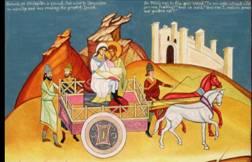 Objectives:
Objectives:
- Understand that Pentecost is the birthday of the Church.
- Know that the Holy Spirit descended at Pentecost.
- Understand the importance of baptism and chrismation.
Possible Lesson Plan:
- Open with prayer.
2. Read the stories in Acts 2:1-8, 14-15, 36-47 and Acts 8:26-40. Review with the students the story of Theophany, the baptism of Jesus. Where was he baptized? By whom? Who spoke and what appeared? Look at the icon and review.
Discussion: What happened at Pentecost? Who descended? Who is the Holy Spirit? In which other feast did we meet the Holy Spirit? (as a dove at Theophany) In what sacrament do we receive the Holy Spirit? (Chrismation - Greek “chrisma” meaning anointing) How does the Spirit, God Himself, dwell in us? How can we tell He does – did we see tongues of fire? This is a great mystery, as are all the sacraments. Why is He called “Comforter”?
Why do we decorate the Church in green? (as a sign of the life the Holy Spirit brings us) In what way is Pentecost the birthday of the church? (the first Christians were baptized by the apostles) What changed the frightened disciples into the power-filled apostles? How did the apostles use their new power in the Holy Spirit?
Why were there so many Jews in Jerusalem from all over the world at that time (50 days after Passover) anyway? (They are also celebrating Pentecost, the giving of the Law 50 days after Passover on Mt. Sinai; it is also the “Feast of Weeks” and the thanksgiving for the harvest) So the Old Covenant Pentecost, the Law, is supplanted by the New Covenant Pentecost, the Spirit.
How do we end the Pentecost celebration? (with kneeling vespers, we again kneel in a spirit of penitence, which we will keep until the next Paschal season.
Discuss the story of the Ethiopian a bit. Philip was told by God to talk to this stranger. It takes a lot of nerve to walk up to some stranger and strike up a conversation, especially one about God. Can you walk up to the new kid in the playground and tell them the good news about Jesus and His resurrection? Every day God puts people in our lives who do not know the Lord. How could we share the love of Jesus with these people? “Gospel” means “good news” and people need good news today for sure. Because Philip told him about Jesus, the Ethiopian believed, was baptized, and took the good news back to his home in Africa!
- We’ve now met all the Persons of the Trinity. This is a mystical concept, confusing to even adults. But let’s discuss it briefly. Practice making the sign of the cross and saying “in the name of the Father, of the Son, and of the Holy Spirit.” Who is the Father? Remind the children of the Lord’s Prayer; say it together. Who is the Son? (Jesus) Who is the Holy Spirit?
- Simple craft? Take 3 craft sticks and glue together in a triangle. Write Father, Son, Holy Spirit on each one. One triangle, 3 sides. Trinity snack? How about 3-flavor Neopolitan ice cream? 1 sundae, 3 flavors.
5. Review the service of baptism: What happens and why? How many were baptized at Pentecost? What was the first thing Philip did with the eunuch from Ethiopia? Why was this step important? With Pentecost and the baptism of the minister from Ethiopia, God’s word about Jesus was already spreading. Many of the people baptized at Pentecost settled in Jerusalem, but many returned to their own countries. The minister returned to Ethiopia in Africa and there began the Ethiopian Church, still in existence today.
|
Action |
Meaning |
|
1. We face the East. |
Light comes from the East; God gives light to our souls. |
|
2. Priest breathes on the face of the child. |
God breathed life into Adam; Baptism will breathe New Life into the soul. |
|
3. Priest’s hand on child’s head. |
Child enters the shelter of the Church. |
|
4. Exorcism: Face West.
Spit on Satan. |
Drives Satan away: West means Darkness; Satan is the Prince of Darkness. Shows our hatred of the devil. |
|
5. Profession of Faith (Creed), facing altar. |
Testify to our Faith in God, turning to Him and from Satan. |
|
6. With his hand, Priest makes a cross in the water; he then blows on the water and prays. |
All evil is driven from the water, which is made holy. |
|
7. Oil is poured on the water. |
Purifying of Baptism (water) is only possible through God’s Holy Spirit (oil). |
|
8. Anointed of parts of body with oil. |
Oil of gladness for healing, in preparation for His new life. |
|
9. Dipping 3 times in the name of the Trinity. |
All sins are washed away: buried with Christ (under water) and risen with Christ: Child dies to sin and is born again to God. |
|
10. White robe of holiness. |
Clean and pure new life in Jesus. |
- Now think about the service of chrismation, the descent of the Holy Spirit, which occurred the first time at Pentecost. How did the Spirit descend then? Do we see tongues of fire now?
|
Action |
Meaning |
|
1. Anointing with holy chrism of the child’s forehead, eyes, nose, lips, ears, chest, hands, and feet |
“The Seal of the Gift of the Holy Spirit” – our entire body becomes the temple of the Holy Spirit |
|
2.Sponging off of the holy chrism. |
God’s work is now invisible, in the way we think and live and act. |
|
3. Tonsure – cutting a lock of hair in the shape of a cross |
Dedication of our who life to God forever. |
|
4. Procession – around to baptismal font and then to the Eucharist |
The door is now open to full and complete communion with God. |
- Play a learning game: Bible Match – Write a question from today’s lesson on one slip of paper and the answer on another. Give each student one piece of paper. Each student must find his partner; the one with the answer to the question. Then they sit down together. If class is small, you may need to play twice.
How did the Holy Spirit appear at Pentecost? Tongues of Fire
Who preached at Pentecost? Peter
How many were baptized at Pentecost? 3000
Who baptized the eunuch? Philip
Where was the eunuch from? Ethiopia
6. Make a Diorama: Take a shoebox. Glue light blue paper in the back and decorate with
Clouds of cotton, etc. Instead of grass on the bottom, since this is the desert, try sandpaper. Make chariot with a cup and wheels of cardboard with a pipe-cleaner axle and shafts. People can either be made from pictures cut from icons and taped to a pipe-cleaner stand or shaped completely from a pipe-cleaner (2 for a horse). Stick legs in clay to stand up. Arrange nicely in box. Can you tell the story from your diorama?
Too involved for your space and time period? Take the icon figures, cut them out, bend the bottom back so they will stand up. Tape or staple to a piece of sandpaper on a paper plate.
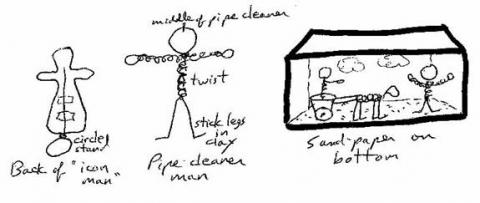
- Close with prayer: Lord, help me to share your love with someone each day, as Philip did with the eunuch.
St. Stephen
STEPHEN
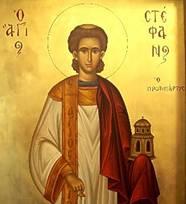
Objectives:
- Know that Stephen was the first martyr.
- Know that a martyr is someone who dies for his belief in Jesus.
Possible Lesson Plan:
- Open with prayer.
- Read the story in Acts 6:1-14, 7:51-60. Review here the definition of martyr.
- Stephen was one of the first deacons. Let’s look for a moment at the development of the first church in Jerusalem. After baptism, many of the people chose to sell all they had and live together. What a wonderful community life that must have been – all their meals together, everyone talking all day about Jesus. Sort of like a big Christian family. But, as in most families, arguments developed. Someone got the best seat, the bigger piece of bread, the nicer shawl. The apostles were too busy preaching to deal with these constant concerns. Peter and the other apostles chose seven men to help them in caring for the early Church. These were called deacons. The apostles continued to spread the gospel. A deacon is a priest’s helper. He helps in the Divine Liturgy and helps the priest by visiting the sick, praying for people, etc. Do we have a deacon?
- Play a learning game: “Scramble” – Make small cards each with one letter one it; be sure to have at least two of each consonant and 4 of each vowel (or bring your Scrabble pieces). Lay them all out on the table or floor. Ask questions from the lesson and at the word “Go!”, the students scramble to form the answer with the letters. Questions must be ones with a one-word answer.
What is someone who is killed for their faith called? Martyr
Who was the first martyr? Stephen
What was Stephen’s role in the church? Deacon
Where was Stephen killed? Jerusalem
How was Stephen killed? Stones
Who held the coats? Saul (or Paul)
5. Make a Come-Alive Mural: Take a HUGE piece of bulletin board or brown wrapping paper. Stephen will be on his knees on one side, a group of figures throwing stones in the middle, Saul holding the coats on the other side. Have the students take turns lying down on the paper and draw around them for the figures. Add clothing and color. Cut out faces. Hold the paper near a wall. The students can stand behind their figure with their faces in the picture. When everyone’s had a chance and pictures are taken, put the mural up on the classroom wall, or cut apart and let each child take home his figure.
6. Close with prayer: Lord help me to love you so much that, like Stephen, I would be willing to die for you.
Conversion of Saul
CONVERSION OF SAUL
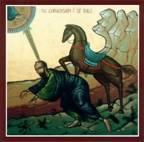 Objectives:
Objectives:
- Who was Saul?
- What was Saul doing at Stephen’s stoning?
- How did Saul meet Jesus?
Possible Lesson Plan:
- Open with prayer.
- Read the story in Acts 9:1-25. We know only a little of Saul’s early life. He was born a tentmaker of Tarsus. He was a Roman citizen. He went to Jerusalem to study with the famous rabbi Gamaliel. His dedication to the Jewish faith led him to violently oppose the new Christian Church. His conversion to Christianity, then, is a very important event because the entire life of Paul was changed. And, in the years to come, St. Paul would become the leading missionary to the Gentiles. Remind the students that the Saul in this chapter had the Greek name, Paul, and these are the same person.
- See what it’s like to be blind: In a pillowcase, put various objects of different textures and shapes. Blindfold the children and see how many they can identify. Fill various small bottles with smelly objects (banana, cinnamon, garlic, pickle, peanut butter, onion, etc.) See if the blindfolded children can identify the things by smell alone.
- Play a learning game: The Big Step – Ask questions from today’s lesson with the students lined up at the far end of the room. If the student can answer the question, he can take one step toward you. If not, the question passes to the next player. First to reach the teacher’s wall is the winner. Sample questions:
Who held the coats at the stoning of Stephen? Saul
Where was Saul born? Tarsus
Where was Saul traveling from? Jerusalem
To what city was Saul traveling? Damascus
What did Saul see on the road? Bright light
What did the voice say to Saul? Saul, why are you persecuting Me?
What happened to Saul’s eyes? Blind
Who came to pray for Saul? Ananias
How did God speak to Ananias? Vision
How did Saul escape the city? Basket over the wall
- Make a Picture Projector. Take a paper towel tube. Cut off about 1 inch at one end. Tape two Popsicle sticks side by side to hold the two pieces of tube together, leaving a ¼ inch slit between the tubes. Take a long, thin strip of paper divided comic-strip style into 4-5 sections. In each section, draw a scene from the story. Insert the paper “film” into the “projector”, hold it up to the light, and tell the story with your pictures. A sample is included but it's even more fun and educational to make your own!
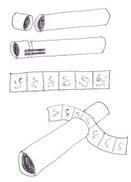
- Close with prayer: Lord, may I keep my eyes open to all that You do in my life.
St. Peter and Cornelius
PETER AND CORNELIUS
 Objectives:
Objectives:
- Students should be able to tell the story of Peter and his vision.
- Students should know the meaning of the words “Jew” and “Gentile”.
- Students should be able to understand the importance of the baptism of a Gentile and the conclusion Peter drew from the descent of the Holy Spirit immediately.
Possible Lesson Plan:
- Open with prayer.
- Read the story in Acts 10. Discuss the meaning of the word, “Jew”, and say it a few times. Remind the students about the story of Abraham (or reread it) and how God chose this people. For what purpose? To prepare for Jesus, the Messiah. The Jewish people called all other people “Gentiles” and did not associate with them. Can the students recall any instances when Jesus did talk to a non-Jew, or even perform a miracle? (the Samaritan woman at the well, the Roman centurion’s servant) . Remind them also (or reread) that God gave a strict law to Moses that included which animals were “clean” and which “unclean”. “Unclean” animals were not allowed to be eaten, just as we do not eat meat during Great Lent. Review the definition of clean: animals that have divided hooves and chew cud and sea creatures with fins and scales. Look at pictures of animals to see the hooves and fins and scales; bring pictures of animals (or a book from the library) to class as a reference for the next activity.
3. Have the students choose from those below clean and unclean and look at pictures and discuss their eating habits to make your decision. You could use stickers and a sheet of construction paper divided into two columns; let the students put the correct side of the paper.
Clean Unclean
Cow Salmon Pig Shrimp Frog
Lamb Bluefish Rabbit Oyster Turtle
Goat Deer Dog Crab Bear
- Play a learning game: Quotations – Have the students identify the speaker:
“Now send men to Joppa, and send for Simon whose surname is Peter.”
“Rise, Peter, kill and eat.”
“I have never eaten anything common or unclean.”
“Behold, three men are seeking you.”
“I am he whom you seek.”
“Stand up; I myself am also a man.”
“I sent to you immediately, and you have done well to come.”
“In truth I perceive that God shows no partiality.”
“Can anyone forbid water, that these should not be baptized..?
5. Make Peter’s dream on a sheet: Take a handkerchief or other piece of white fabric or a piece of a sheet. Glue to it stickers of “unclean” animals or even animal crackers. Tie a string to each corner so it can be raised and lowered as you retell the story. No sheet? How about a coffee filter, using pipe cleaners for the corners? Or even a paper plate…
6. Close with prayer: Lord help me to love everyone this week with Your love.
Council in Jerusalem
THE COUNCIL OF JERUSALEM
 Objectives:
Objectives:
- Who was there?
- Where did the first council meet?
- What did they decide?
- Why was the fish an early symbol of Christianity?
Possible Lesson Plan:
- Open with prayer.
- Read the story in Acts 15:1-35. This was the earliest of the church councils. Who were the major apostles attending? (Peter and Paul) But who presided? (James, not the disciple but a relative of Jesus) Who made the decision? This decision opened the church fully to non-Jews, once and for all. Do you remember what non-Jews were called? (Gentiles)
- Enjoy Jewish culture a bit: Talk about Hanukkah – dreidls and potato latkes – and Passover. Remind the students about God’s choosing of the descendants of Abraham through Isaac as His people; the circumcision of the boys was required as a symbol of this choosing. Remember the story of Moses and God’s people escaping from Egypt? Show a picture from a library book of a Jewish wedding with the canopy. Look at pictures of synagogues and Jewish people in prayer shawls. Many of these customs are like ours but many are not. Talk a little about our customs and holidays. It’s fun to learn about other people’s customs, but how would you like to be told you had to dress and eat and celebrate exactly like your Jewish friends?
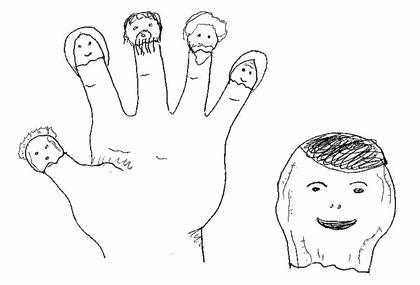
 The earliest non-Jewish believers were mostly Greeks. Take a look at the Greek alphabet. If you take the first letters of the words, “Jesus Christ, Son of God, Savior,” in Greek and put them together, you get the Greek word for “fish”. For this reason, early Christians often identified themselves to each other with a simple drawing of a fish.
The earliest non-Jewish believers were mostly Greeks. Take a look at the Greek alphabet. If you take the first letters of the words, “Jesus Christ, Son of God, Savior,” in Greek and put them together, you get the Greek word for “fish”. For this reason, early Christians often identified themselves to each other with a simple drawing of a fish.
- Play a learning game: 20 Questions. Write the names Peter, Paul, James on three slips of paper. Students choose a slip. Then the other students ask “yes” or “no” questions (up to 20) to identify the character.
6. Make Peanut People Finger Puppets: Break peanuts in half for each puppet. For this story, try Peter, Paul, James, Silas, and Judas. Draw on faces and add cloth or paper headcoverings, yarn hair and beards, etc. Practice telling the story with the finger puppets. Someone allergic to peanuts? No problem! Take small strips of paper or cardstock, roll into finger-sized cylinders, and decorate the same way for paper finger puppets.
7. Close with prayer: Lord, help us to make decisions fairly and wisely every day.
Spread of the Gospel
SPREAD OF THE GOSPEL
Objectives:
- Students should be able to name the early apostles.
- Students should know where at least some of them traveled.
3. Students should be able to tell what “evangelism” means.
Possible Lesson Plan:
- Open with prayer.
- Tell the story of the apostles as given on the next two pages, have a globe or map handy to show the destinations of these travelers; write the name of each apostle ahead of time on a post-it and stick to the map as you go:
LIVES OF THE APOSTLES (IN BRIEF)
Where did they all go, these men who followed Jesus so closely? Let’s look quickly at their lives after the Ascension and Pentecost.
St. Andrew, the first-called, a fisherman by trade and brother of Peter, traveled to Scythia, Greece, a small town then called Byzantium (later known as Constantinople!), and to Russia to the River Dniepr, where the cities of Kiev and Novgorod would later be built. He is the patron saint of Russia. He finally traveled to Patras, in Greece, where through his prayers many were healed, including the wife of the governor. But the governor ordered Andrew tied to an X-shaped cross, Andrew continued preaching the whole time he was on the cross for 2 days until his death.
St. Thomas, better known as “Doubting Thomas” because of his doubts about the Resurrection, surely had no doubts after he saw Jesus with his own eyes. He traveled to far-off India to spread the good news of his faith and there, he died.
St. Bartholomew was born in Cana of Galilee and first was sent by the apostles to Syria and Asia Minor. In the city of Hieropolis, there lived a man called Stakhios. Stakhios had been blind for 40 years, but was healed through the prayers of the apostle and was baptized. Soon many were being healed and leaving the pagan gods for Christ. This angered the pagan priests, who had St. Bartholomew, along with St. Philip arrested. Bartholomew survived crucifixion there, left Stakhios as bishop, and also is believed to have traveled to India and began the Christian Church there, translating the gospel of Matthew from the Hebrew for the new believers. He then traveled to Armenia, where he preached for many years and healed the daughter of King Polimios through prayer. King Polimios, his wife and daughter, and many people from the ten cities of Great Armenia became Christians. Finally, at the urging of the pagan priests, a wicked king named Astyages in the nearby city of Al’ban ordered Bartholomew killed.
St. Simon (the Zealot) left Palestine and traveled first to Egypt to preach about Jesus. St. Jude left Jerusalem after Pentecost and traveled to the land of Mesopotamia. In and around the city of Edessa he preached the good news of Jesus and the resurrection. Finally, he went to Persia with St. Simon and there, in Persia, both of these courageous apostles died for their faith.
St. James the Greater, son of Zebedee and brother of St. John the Beloved, traveled to Spain to preach; he is the patron saint of Spain to this day and is known there as Santiago (Our own San Diego is named for him.). He returned to Jerusalem to try to influence the Pharisees to accept Christ. But, the Jews still hated the Christians and begged King Herod Agrippa to put James to death. James was the first of the apostles to die and the second martyr (after Stephen).
St. Philip introduced many members of the Greek community to Christianity. After performing many miracles in Jerusalem, including giving sight to the blind and restoring life to a dead infant, he traveled with is sister, Mariamne, to Phrygia in Asia Minor. There he preached to the people of Hierapolis. These people worshipped a huge snake; Philip prayed and the snake died. Many people who had been bitten by snakes were healed, including the wife of the governor. Many of the people then believed in Jesus, but some were so angry they put Philip in prison. When Philip would not deny Jesus, he was crucified, head down, along with the Apostle Bartholomew. A great earthquake struck, and Philip prayed for the safety of those present. The earthquake stopped, and Philip and Bartholomew were taken down from the cross. Bartholomew was still alive and established a bishop for the newly-converted people of the city, but Philip, through whose prayers the city had been saved, had already gone home to be with his Lord.
St. Matthew remained for many years in the land of Israel, teaching the Jewish people about Jesus. He wrote the gospel of Matthew to tell the story of Jesus to his people. Finally, he traveled to Ethiopia to preach and was killed by those who hated Christians in that African land.
St. James the son of Alpheus, also known as James the Less and brother of St. Matthew, traveled after Pentecost first to the city of Eleutheropolis and then to Egypt. There he preached and performed miracles with great success and churches were founded. Finally he was killed in the town of Ostracina, being crucified by pagans.
St. Matthias was chosen by casting lots to take the place of Judas Iscariot, who betrayed Jesus. He had been on of the 70 men sent out by Jesus to preach and perform miracles. He was with the other 11 disciples at Pentecost and preached in the land of Judea. Then he traveled to the land of Cappadocia and began the church there. He also died for his faith.
There are 2 other very special apostles, even though they were not part of the first 12 chosen by Jesus.  St. Barnabas was actually named Joseph; the apostles changed his name to Barnabas, which means “Son of Encouragement”. St. Barnabas was born on the island of Cyprus, and was a fellow-student of Saul (later to be St. Paul) in Jerusalem under the teacher, Gamaliel. He became a follower of Jesus and was one of the chosen Seventy. We see glimpses of his work in the book of Acts. He was one of those who sold all he had in the early church in Jerusalem. Next we see him leading the newly converted Saul back to Jerusalem to meet the other Christians there. He was sent by the church in Jerusalem to Antioch, where believers were first called Christians. After a year in Antioch with Paul, the two set out on their first missionary journey. They took with them on that journey a cousin of St. Barnabas, John Mark. John Mark, later the Evangelist Mark, left the two apostles part-way through the journey. Barnabas also traveled with Paul to Jerusalem for the first church council. But, when Paul refused to trust John Mark to come on his next journey, Barnabas took Mark to Cyprus. Barnabas then traveled to Rome, perhaps the first to preach there about Jesus. He traveled to Mediolanum (now Milan) in Italy and then returned to Cyprus. There, St. Barnabas and St. Mark preached together for many years until Barnabas was stoned to death in Salamis in about the year 62 at age 76.
St. Barnabas was actually named Joseph; the apostles changed his name to Barnabas, which means “Son of Encouragement”. St. Barnabas was born on the island of Cyprus, and was a fellow-student of Saul (later to be St. Paul) in Jerusalem under the teacher, Gamaliel. He became a follower of Jesus and was one of the chosen Seventy. We see glimpses of his work in the book of Acts. He was one of those who sold all he had in the early church in Jerusalem. Next we see him leading the newly converted Saul back to Jerusalem to meet the other Christians there. He was sent by the church in Jerusalem to Antioch, where believers were first called Christians. After a year in Antioch with Paul, the two set out on their first missionary journey. They took with them on that journey a cousin of St. Barnabas, John Mark. John Mark, later the Evangelist Mark, left the two apostles part-way through the journey. Barnabas also traveled with Paul to Jerusalem for the first church council. But, when Paul refused to trust John Mark to come on his next journey, Barnabas took Mark to Cyprus. Barnabas then traveled to Rome, perhaps the first to preach there about Jesus. He traveled to Mediolanum (now Milan) in Italy and then returned to Cyprus. There, St. Barnabas and St. Mark preached together for many years until Barnabas was stoned to death in Salamis in about the year 62 at age 76.
Finally, St. Luke, the Evangelist, was also an early companion of Paul. He was a Roman citizen and physician from the ci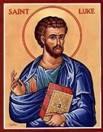 ty of Antioch. He traveled with Paul through Asia Minor on Paul’s second missionary journey. He wrote down all they did and all he learned about the life of Jesus; we can still read these today in the Acts of the Apostles and the Gospel of Luke. He painted an icon of the Virgin Mary, which he gave to the Theotokos herself; this is still a prized possession of the Patriarchate of Constantinople. Luke lived to be an old man and died in Thebes at the age of 84.
ty of Antioch. He traveled with Paul through Asia Minor on Paul’s second missionary journey. He wrote down all they did and all he learned about the life of Jesus; we can still read these today in the Acts of the Apostles and the Gospel of Luke. He painted an icon of the Virgin Mary, which he gave to the Theotokos herself; this is still a prized possession of the Patriarchate of Constantinople. Luke lived to be an old man and died in Thebes at the age of 84.
- Have each student concentrate on one saint: Make an Illustrated Biography book with each student drawing a picture of the life of one of the apostles. Put the name of the apostle at the top of each page. Have the student tell the others about “his” apostle. Then punch holes along the side and mount with a piece of ribbon or yarn as a class book.
- One could write a little ditty, having the students pick out one fact they think is important about each character and singing to the tune of the 12 Days of Christmas – for example:
The first of the apostles was Andrew; he is the patron saint of Russia.
The next of the apostles was Doubting Thomas, India was his goal and Andrew
Patron saint of Russia.
The next of the apostles was Simon Zealotes, traveled to Egypt; Thomas went to
India, and Andrew patron saint of Russia. Etc., etc.
- Play a learning game: Matching game. Take an index card for each apostle. Fold in half. On one half write the name and on the other, the destination. Cut in half. Make two piles. Have students draw from the names pile until the names are all taken; these cards are their “hands”. One by one in turn draw a destination. Student can put the person and destination down together if they match. If not, discard the destination. Continue until all pairs are matched correctly.
- Alternate idea: Write a brief description of the saint’s life on one side of flash cards cut into fish, with a picture of the saint and/or the name on the other side. The blurbs, pictures, and fish pattern are on the next 5 pages.
7. Close with prayer: Lord, make me as brave as the apostles in telling everyone about
You.
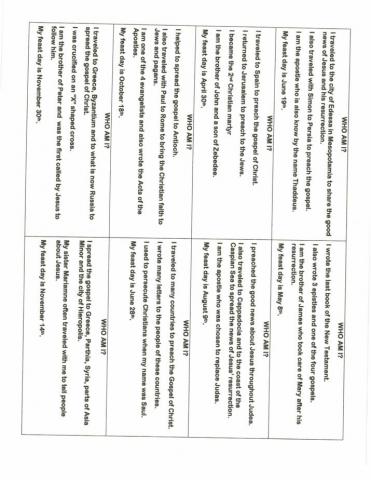
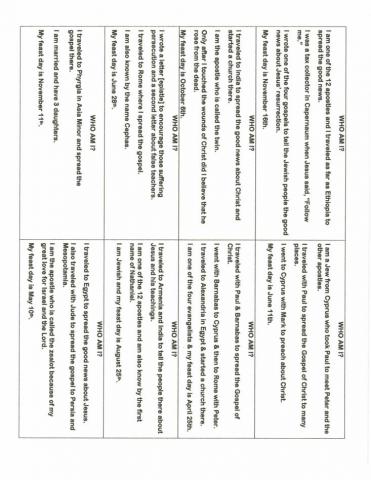
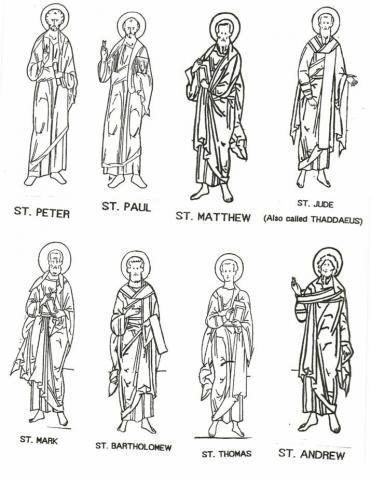
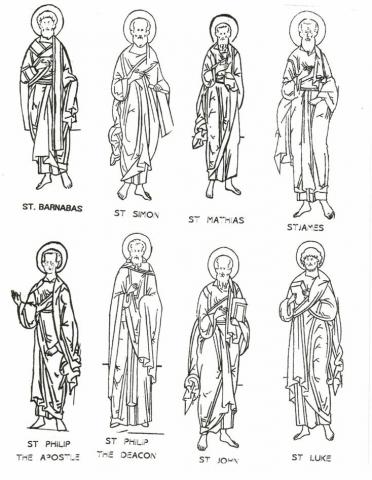
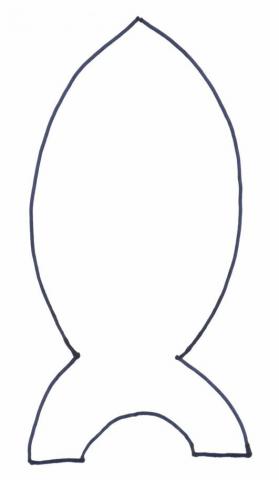
St. John and the Revelation
JOHN/REVELATION
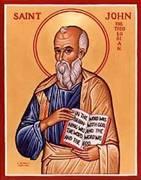
Objectives:
- Students should be able to identify the apostle John as the disciple John, son of Zebedee and brother of James.
- Students should be able to identify the Book of the Revelation as John’s writing.
- Students should be able to identify the Second Coming.
Suggested Lesson Plan:
- Open with prayer.
- Have each of the students read one of these passages and summarize for the group; they are in chronological order: Luke 5:7-11, Mark 5:35-42, Mark 6:7-13, Luke 9:28-32, John 13:21-26, John 19:25-27, John 20:1-8, Acts 3:1-6, I John 1:1-3, Revelation 1:9-11. Supplement with the following story; have ready the icons of the Transfiguration, Crucifixion, Ascension, and Pentecost to identify John in each (and break up the story):
After the Resurrection, John was one of the leaders of the early Church. He helped Peter and James in guiding the church in Jerusalem. Then, John traveled to Asia Minor and settled in the city of Ephesus. He wrote down his memories from his life with Jesus in the Gospel of John. From Ephesus he led the church in Asia. John was known for the loving concern he had for his brothers and sisters. A story is told that, while traveling in a certain city, John saw a young man and entrusted him to the bishop of the city to teach him about the Lord. But, when John came back to the city, he was told that the young man had made bad friends and had become a robber. This made John very sad, and he went into the mountains where the robbers lived. He was captured by the robbers and found the young man and told him that Jesus still loved him. The young man then cried and said that he was sorry for his evil way of life and went back to the church. So, the apostle John cared for his churches with love and charity.
When John was already an old man, loved by Christians everywhere, he was the only one of the twelve still alive. When the Emperor Domitian, a cruel and wicked ruler, came to the throne, he ordered John captured by the soldiers and brought to the Emperor in Rome. There, he tried to kill John in a pot of boiling oil, but John was not hurt at all. (Remember the story of the three men in the fiery furnace?) Since he could not kill the apostle, the emperor sent him to the deserted island of Patmos. There John had the great vision of the Lord and wrote the book we now call “The Revelation” in the Bible.
Finally, Domitian died and John was able to go back to Ephesus. From there he wrote three letters, which we now have in our Bible as the “Epistles of St. John”. As an old man, John told the people over and over to love each other. John died peacefully in Ephesus and joined the Lord he had loved so well.
- The Book of the Revelation is much to complex and the subject of too much theological controversy to approach with this age group. But – everyone has dreams. Let them discuss their dreams. What is the difference between a dream and a vision? There are many instances of dreams and visions in the Old Testament that we already have studied – the dreams of Pharaoh, the dreams of the butler and the baker, the vision of Samuel, the visions of the prophets (e.g. Ezekiel and the bones). And in the gospels, Joseph had two life-changing dreams – when God told him to marry the Theotokos and when the angel told him to escape from Bethlehem to Egypt. Review these stories. God can speak to us in both visions and dreams. John’s vision was full of angels and trumpets – the major theme is the Second Coming, when Jesus will come again in glory (as He promised) and judge the world.
- Do a learning activity: In Revelation, God sends a message through John to the 7 churches of Asia. Look up the names of these churches in Revelation 1:11. Find each of these churches on a map. Draw a small church shape, write the name of the church, and from Revelation 2 and 3 find one important thing God had to say to each church and write it also on the building. Use thumb tacks to attach the paper churches in the correct locations on your classroom map or bulletin board. Do any of the messages God gave to those long-ago churches apply to us today? Why or why not?
- What is an angel? Ask the students to describe as they understand angels. Angels are God’s attendants and messengers. The Orthodox Church teaches that there are 9 “choirs” of angels: angels, archangels, powers, authorities, principalities, dominions, thrones, cherubim and seraphim. Do the students remember any of these mentioned in our liturgy? Angels are invisible (most of the time; can you think of an exception? The Annunciation!), of tremendous power and strength. They don’t have bodies as we know them. Try to fill these blanks with either “people” or “angels” or “angels and people”:
_______________ were created by God. _________are always young.
_______________have bodies. _________think and do things.
_______________never die. _________need to eat and drink.
_______________have names.
- Make an paper plate angel head: Take a large paper plate before class, cut out the center and spray paint gold (or use gold glitter in class). Take a small plate and draw face and add hair of yarn or fabric or felt. Cut wings from a 12x18 sheet of construction paper in white. Glue or staple face in front of halo and wings behind.
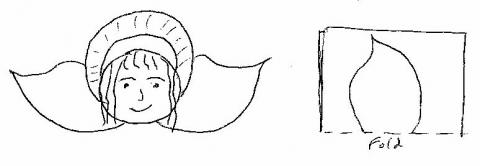
- Close with prayer: Lord, let me see You this week all around me in my dreams and in your invisible helpers, the angels.
St. Paul and his Journeys: Part 1
PAUL AND HIS JOURNEYS
Objectives:
- Students should know that Saul and Paul are the same person.
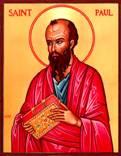
- Students should learn the general plan of Paul’s travels, all around the Mediterranean.
- Students should know that Paul traveled first with Barnabas and John Mark.
Possible Lesson Plan:
- Open with prayer.
- First review the story of Saul’s conversion. Read the 1st part of the story of Paul’s journeys. You’ll spend two weeks on the journeys. Follow his course carefully on your classroom map, or have each student trace each journey on the maps on the following pages. Have each student read one passage, tell the class about it, and place a pushpin in the classroom map for the location. In the end, connect all the pushpins with string. Alternatively, draw lines between dots on each individual student’s map – or do both!
I. First Missionary Journey, 45—51 A.D., Acts 13:13—14:28
A. Antioch, first called “Christians”, Paul and Barnabas: Acts 13:1-3
B. Cyprus
1. Salamis, John Mark joins them: Acts 13:4-5
2. Paphos, Elymas the Magician: Acts 13:6-12
C. Perga in Pamphylia, John Mark leaves: Acts 13:13
D. Pisidian Antioch, shook dust off feet: Acts 13:14-16, 42-52
E. Galatia
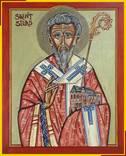 1. Iconium: Acts 14:1-5
1. Iconium: Acts 14:1-5
2. Lystra, Timothy’s home, Zeus and Hermes, stoned: Acts 14:6-20
3. Derbe: Acts 14:20-23
F.Antioch: Acts 14:24-28
II. Apostolic Synod in Jerusalem, 50 A.D. – review this
III. Second Missionary Journey, 53-55 A.D., Acts 15:1-18:22
A. Antioch, Barnabas and John Mark went to Cyprus: Acts 15:36-41
B. Cities in Asia Minor already visited, Timothy circumcised: Acts 16:1-4
C. Troas (Troy), dream of Macedonian man, Silas and Timothy: Acts 16:8-10
D. Neapolis: Acts 16:11
E. Philippi, Lydia, slave girl, earthquake and jailer: Acts 16:12-34 (break this up?)
F. Apollonia: Acts 17:1
G. Thessalonica, house of Jason, sent away by night: Acts 17:1-9
H. Berea: Acts 17:10-14
I. Athens, Mars Hill, Unknown God, Dionysius the Areopagite: Acts 17:15-23, 34
J. Corinth, Aquila and Priscilla (tentmakers): Acts 18:1-11
K. Ephesus, brief visit, left Aquila and Priscilla, Apollos: Acts 18:18-21
L. Caesarea in Palestine: Acts 18:22
M. Antioch: Acts 18:22
IV. Third Missionary Journey, 56-59 A.D., Acts 18:23-19
A. Antioch: Acts 18:22-23
B. Ephesus, John’s baptism, silversmiths of Artemis: Acts 18:24-26, 19:11-12, 19:23-36
C. Macedonia and Greece, joined by Luke: Acts 20:1-3
D. Troas, Eutychus: Acts 20:6-12
E. Islands of Mitylene, Chios, Samos, Miletos, Cos. Rhodes, Patara: Acts 20:13-15, 21:1-2
F. Tyre: Acts 21:2-6
G. Caesarea of Palestine, Philip the Evangelist, Agabus: Acts 21:7-14
H. Jerusalem: Acts 21:15-19
V. Fourth Missionary Journey, 59-64 A.D., Acts 22-28
A. Jerusalem, vow of purification, arrest, Sanhedrin, plot: Acts 21:26-33, 22:23-27, 23:12-1
B. Caesarea, Felix and Festus, King Agrippa, appeal to Caesar: Acts 23:23-24, 33-35, 24:27, 25:9-12, 25:22-25
C. Crete, storm: Acts 27:1-8, 18-26, 41-44
D. Malta, snakebite: Acts 28:1-6
E. Rome, 2 years house arrest, Nero’s persecutions: Acts 28:11-16, 30-31
F.Death by beheading
- Try Events in Acts quiz – Who am I? Where am I? Give each student a piece of paper. Make two columns and number questions 1-5:
Paul stays with tentmakers. Priscilla and Aquila Corinth
Helper joins Paul and Barnabas. John Mark Salamis
Dream of a Macedonian man. Paul Troas
Two prisoners baptize a jailer. Paul and Silas Philippi
Sermon about an unknown god. Paul Athens
- Make Paul’s Basket: Take a berry basket or similar of plastic. Tie a one-yard length of yarn to the top corner. Weave in and out of holes around the basket, working your way down, tying on another length of yarn as needed. Add 4 pieces tied to the top as a hanger; this can be used for hanging small plants.
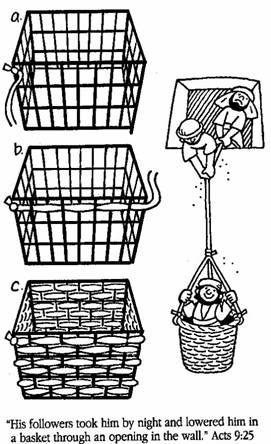
- Close with prayer: Lord help me to trust you to take care of me in everything I do.

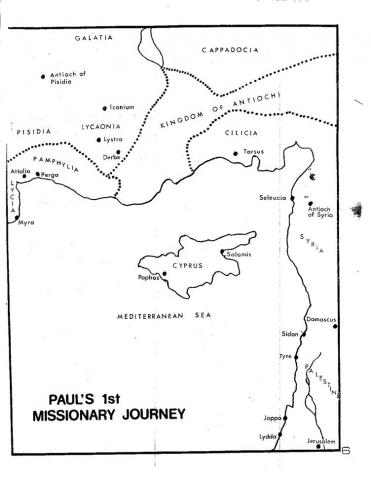
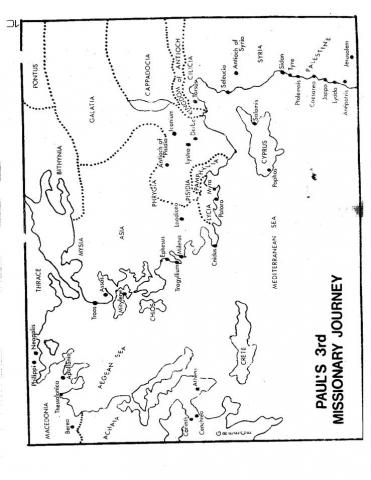
St. Paul and his Journeys: Part 2
PAUL AND HIS JOURNEYS, PART 2
Objectives:
- Students should know the general plan of Paul’s travels all around the Mediterranean.
- Students should know that Paul traveled later with Silas.
3. Students should know that Paul traveled last to Rome as a prisoner and died there.
Possible Lesson Plan:
- Open with prayer.
2. Continue reading the story of the journeys of Paul and tracing them on your map. Review the name “Silas” as Paul’s traveling companion on his later trips. Do the students remember anyone else from earlier lessons who traveled with Paul? (Luke, the physician, Barnabas and John Mark). Who wrote down the story of Paul’s travels? (Luke) In what book of the Bible is this recorded? (Acts) Paul went to Rome as a prisoner. He was beheaded there. So, Paul, too, was a martyr; review the word. Why was Paul in jail? Was he guilty of a crime? What crime? Is it illegal today to be a Christian? In our country? In other countries?
- Continue your Events in Acts quiz:
Craftsman creates an uproar. Demetrius Ephesus
Young man falls out of window. Eutychus Troas
Prophet warns Paul about Jerusalem. Agabus Caesarea
Roman official hears Paul’s defense. Felix Caesarea
Paul almost persuades ruler to be Christian King Agrippa Caesarea
Paul is shipwrecked with centurian. Julius Malta
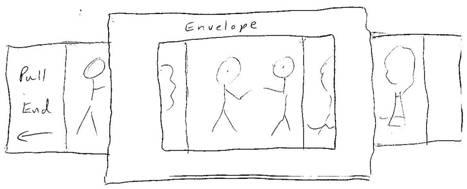 Make an Envelope Viewer: Cut a TV-screen hole in the front of a business-size envelope. Lick the envelope shut and cut off both ends. Color the movie strips on the next pages, or have students draw their own. Do the students recognize the scenes depicted – Paul healing the cripple, Paul in the Philippian jail, Paul’s call to Macedonia, Paul in Athens, the fall of Eutychus, Paul in Ephesus, and shipwreck on the way to Rome? Insert the strip in the viewer and pull through to see the story. Can the students tell the story with their “movie”?
Make an Envelope Viewer: Cut a TV-screen hole in the front of a business-size envelope. Lick the envelope shut and cut off both ends. Color the movie strips on the next pages, or have students draw their own. Do the students recognize the scenes depicted – Paul healing the cripple, Paul in the Philippian jail, Paul’s call to Macedonia, Paul in Athens, the fall of Eutychus, Paul in Ephesus, and shipwreck on the way to Rome? Insert the strip in the viewer and pull through to see the story. Can the students tell the story with their “movie”?
- Close with prayer: Lord, help me to follow You no matter where You lead me as did St. Paul.
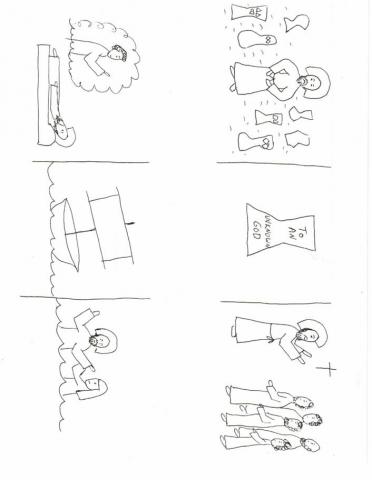
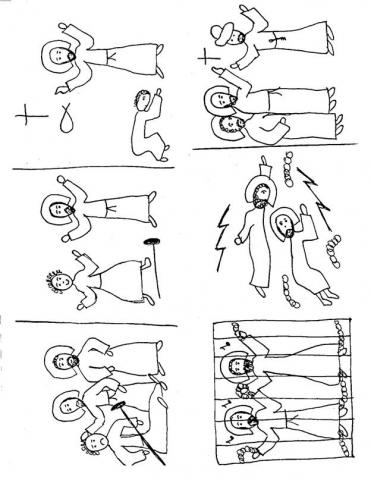
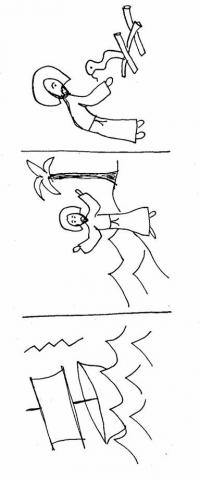
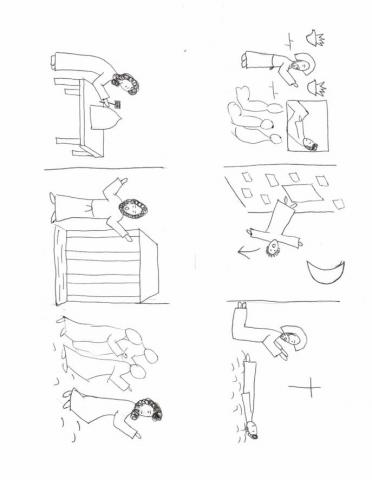
St. Peter
PETER
Objectives:
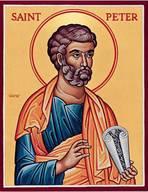 Students should know that Peter was one of Jesus’s twelve disciples.
Students should know that Peter was one of Jesus’s twelve disciples.- Students should know that Peter started the church in Rome.
3. Students should know that Peter died as a martyr, upside down on a cross in Rome.
Possible Lesson Plan:
- Open with prayer.
- Again, use the Scriptures to review the life of St. Peter:
Mark 1:16-18 Calling as a fisherman
Mark 3:13-19 Choosing of the twelve/ nickname Peter (the rock)
Matthew 14:22-33 Walking on water
Matthew 16:13-19 Keys to the kingdom
Matthew 17:1-6 Transfiguration
Luke 22:54-62 Denial
John 21: 1-19 Feed My Sheep
Acts 2:14-15, 37-41 Pentecost
Now for some new scenes in his life:
Acts 3:1-10 Healing the Lame Man
Acts 4:1-3, 18-22 Brought before the Sanhedrin
Acts 5:17-25 Freed from Prison, Preaching in Temple
Acts 9:36-43 Raising of Tabitha (Dorcas) from the dead
Acts 10 Peter and Cornelius – review this, already read
Acts 12:3-17 Miraculous escape from prison
Acts 15 Council in Jerusalem – review this, already read
Peter finally traveled to Rome. He was the first bishop of Rome and was crucified upside down by the Emperor Nero on the same day St. Paul died.
- Peter was also one of the Lord’s greatest apostles. Work a bit on the words “disciple” and “apostle”. Say the words and have the students repeat them. Peter was both – the disciples were the original followers of Jesus who studied and lived with the Lord during His life on earth. So, a disciple is a student, a follower. How many of the original twelve can the students name? One man was chosen to take the place of the one who betrayed Jesus? Who betrayed Jesus? Who took his place? How was Matthias chosen? “Apostle” is someone sent out by the Lord to establish His Church. So, an apostle is a leader, a teacher. Peter was a disciple who, on Pentecost became an apostle. What happened on Pentecost? Paul never knew Jesus on earth but was sent by Him to establish churches all over the Mediterranean world. See if the students can land these famous people in the right category:
Disciple Disciple and Apostle Apostle Neither
Judas Iscariot Peter Paul Abraham
Thomas Silas David
Andrew Luke Daniel
John
James
Are there still apostles in modern times? Watch future lessons for the answer.
- Play a learning game: Final Jeopardy: Write answers, each on one sheet of paper. Give each student a sheet of paper. Hold up an answer and give about 1 minute to write a question. Some possible answers:
Lame Man
Tabitha (Dorcas)
Cornelius
Simon the Tanner
Angel
Rhoda
Nero
-
We will make a very small book, with pictures from the life of St. Peter to color inside; can you tell each of these stories? Then fold and enjoy! Pattern is on the next page. Begin by printing the page on white copy paper. Fold down the middle lengthwise and widthwise, then fold again widthwise to make a fold between each picture. Unfold and LOOK. Fold carefully lengthwise and CUT with scissors down the middle line ONLY between the two middle pictures, leaving the paper intact on the ends. Refold, bulging the two middle sections so the blank sides turn back to back, locating the front and back (words and icon of Peter and Paul). Entire booklet should fall into place with eight small pages. Fold firmly.
6. End with prayer: Lord, make me now Your good disciple learner.
Dormition
DORMITION
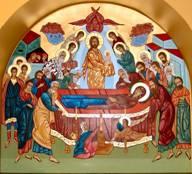 Objectives:
Objectives:
- Who was at this major event?
- What happened?
- When did it happen?
- Where did it happen?
Possible Lesson Plan:
- Open with prayer.
- Read the story, using the icons of the Nativity, Crucifixion, and Dormition:
Mary was the Mother of Jesus, the Theotokos. God was His Father. When Jesus was a baby, Mary cared for Him and fed Him and gave Him His bath. But, all that time, she knew that this baby was different from other babies: He was the Son of God. Mary spent thirty years doing all the things a mother and wife must do. She cooked and cleaned and scrubbed and sewed. Her bare feet were dusty from the hard work of her little home in Nazareth.
Later, when Jesus was grown, He left home to begin His life’s work. Mary saw little of her Son during the years of His teaching and miracles. But, she still loved Him as mother loves her child. Mary was at the foot of the cross when her Son, Jesus, was dying there. Jesus saw her and knew how sad His pain and suffering made His mother. He called out to His disciple, John. John was to care for Mary as if she were his own mother. And so, for the rest of her life, he cared for the Theotokos as a loving son.
After the day of Pentecost, Mary stayed in the city of Jerusalem, living with the disciple John. She comforted and worked lovingly with the new Christian church.
When Mary was about 50 years old, she was sick and dying. She told her friends that she wanted to be buried in Gethsemane, the garden where Jesus prayed. At that time, all of the apostles were scattered around the world preaching the Gospel. When they heard of Mary’s dying, they all returned to Jerusalem. Some made the journey by foot; others were miraculously transported by the Lord Himself. All arrived in time except St. Thomas, also known as Doubting Thomas. The apostles are pictured on either side of Mary, St. Peter at the head of the bier and St. Paul at the foot of the bier. With everyone gathered, Mary “fell asleep” in Christ. She died peacefully, knowing that the resurrection of her Son would also be hers.
Below the bier in the icon we see Antoninus the Jew. He was an enemy of the Christian community and tried to break up the burial of Mary by dumping over the bier. An archangel appeared and cut off the hands of Antoninus to keep him from dishonoring the Theotokos.
When Thomas arrived, the other disciples took Thomas to the tomb in Gethsemane where Mary had been buried near her parents, Joachim and Anna. But the tomb was empty! The Church believes that Mary was resurrected bodily and taken to heaven, just as we all will be in the future.
- Discuss the association of flowers with this feast. According to tradition, when the apostles went to visit the tomb of Mary, instead of finding her body, they found only the burial cloths and the tomb was filled with the fragrance of flowers. We bring flowers to church to be blessed and place them at the icon of the Theotokos. We can then take home the flowers to give her fragrance to our homes.
- Why do we fast before Dormition? In a family, when the mother is dying, normal life comes to a halt. Parties, TV – they seem wrong at such a time. All gather around the dying mother. So, in the church, as the Mother of God is on her deathbed, we also come to her deathbed and our focus is away from such things as fancy meals, personal wants, and daily routines. We spend time reflecting on she who gave us Christ, contemplation of her life, and preparing ourselves to live a life like hers.
- Play a learning game: Don’t Make a Move – Write numbers 1-12 each on a popsicle stick. Dump the sticks together in a pile on the table. Each student in turn must draw a stick without moving the others. If he moves the other sticks, he loses his turn and the stick is dropped back on the pile. If he does not move the sticks, he must answer a question from today’s lesson. If he answers, he keeps the stick; if he does not know the answer, the stick goes back in the pile. Student with the most sticks in the end is the winner. Possible questions:
Who were the parents of Mary?
Where did Mary grow up?
Who was Mary’s husband?
What is the name of the feast of the falling asleep of the Virgin Mary?
Where did Mary live in Jerusalem?
How old was Mary when she died?
Where did she want to be buried?
Who was present at her death?
Which disciple was not present at Mary’s death?
Who tried to turn over the bier?
Who cut off the hands of the Jew?
What did Thomas smell at the tomb?
- Make a Popsicle theater. Background could be a gift box or a 12x18 piece of construction paper folded in half to stand up or a shoebox or shoebox lid. Decorate background with flowers. Then cut out the icon pieces on the next page. Color and tape a Popsicle stick behind each figure. Tell the story with your puppets.
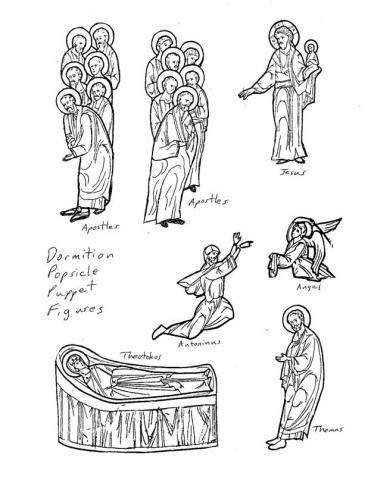
- Close with prayer: Lord, help me this week to feel the closeness that Mary felt with You and the love she had for You.
Persecution: St. Ignatius of Antioch
PERSECUTIONS
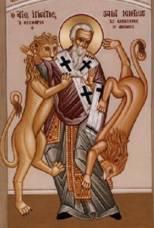 Objectives:
Objectives:
- Students should be able to say the word “persecution” and know its meaning.
- Students should be able to name St. Ignatius of Antioch and tell his story.
- Students should know that we were first called Christians in Antioch.
Possible Lesson Plan:
- Open with prayer.
- Read the story of St. Ignatius of Antioch as follows:
In the early days of the Church, it was dangerous to be a Christian. Many of the Emperors of Rome did not like Christians because they would not worship the gods of Rome and the Emperor himself. Do you remember the stories of the three young men in the fire and Daniel in the lion’s den? (Review them here.) Just like these men who loved God, early Christians were burned and eaten by lions. The Emperor Nero had made it illegal to just be a Christian; he burned the city of Rome and blamed the Christians, making people very angry. The Romans killed Christians only for believing in Jesus. People who are killed for what they believe are called martyrs.
By the year 100 AD, all of the apostles who had known Jesus personally were dead – most as martyrs. Do you remember how St. Peter died? But many of those who had known the apostles themselves were still alive. These men were called Apostolic Fathers. One of these was Ignatius, Bishop of Antioch, the city where Christians were first called Christians. St. Ignatius was a martyr. Here is his story:
As a young boy, Ignatius felt the Lord Jesus hug him and, from that day forward, he grew so close to the Lord in prayer that he became known as the "God-bearer". Ignatius had known the apostles when he was a young man. He was taught by the Evangelist John. He grew to become a priest and then Bishop of Antioch. As bishop he ordained more men as priests and deacons. The church in Antioch was growing and strong. Ignatius preached wisely to his people and was known as a just and fair man. Unfortunately, he was known also to the pagans, who thought that if they got rid of Ignatius the Church would crumble.
Their opportunity came when the Emperor Trajan had a great victory and ordered every citizen to give thanks to the idols of Rome. Ignatius would not sacrifice to the idols and taught the other Christians to worship only Christ Jesus. Ignatius was arrested and found guilty of being a Christian. The judge sentenced him to die in Rome. All along the way, guarded by two soldiers, the bishop was greeted by other Christians. He even met St. Polycarp while passing through Smyrna. (Travel with Ignatius from Antioch to Smyrna to Troas, and then to Rome on your map.) All along the way, Ignatius wrote letters to the churches in various cities, telling them to be strong in the Lord. We still have these letters. He was not afraid to die; he would be with Jesus. Finally, the good bishop reached Rome. There he was thrown to the lions in the arena – a martyr. But, even the lions did not touch the heart of the saint. After his death, many of the faithful saw Ignatius in their dreams, praying for the city of Rome. His courage caused the Emperor Trajan to stop persecuting Christians for the rest of his reign. St. Ignatius of Antioch is remembered by the Church on February 1 each year.
- Review the role of bishop, priest, and deacon. You remember that in the earliest days of the Church in Jerusalem the apostles appointed deacons to help them in the day-to-day running of the Church affairs. By the time of St. Ignatius, we can tell from his writings that the Church even in 100 AD already had the structure that it holds to this day. Each city had a bishop, responsible to God for the welfare of the entire Christian community of that city. These bishops were ordained by the apostles themselves, or bishops ordained by the apostles. The bishops ordained priests to care for each individual church. And deacons continued to help the priests in the daily affairs of the church. Ignatius was particularly concerned with the unity of the Church in the world and in each city.
- Play a Learning Game: Word Jumble – What are the answers to these questions:
I burned Rome and blamed the Christians. RENO
Christians were first called by this name here. TICHONA
I was bishop of Antioch in 100 AD. STAGUINI
I met Ignatius in Smyrna on his way to Rome. RACPOPLY
I was the city where Ignatius died. MERO
I killed Ignatius. NILO
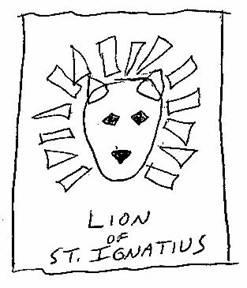 Make St. Ignatius’s lion: Take a piece of wax paper. Cut an oval out of gold or yellow tissue paper. Cut two yellow or told ears. Cut out 2 black eyes and a black nose. Cut some smaller rectangles and long, thin triangles of different shades of brown tissue paper. Now arrange all as a lion with a mane on the wax paper. Cover with another piece of wax paper. Iron on low; wax papers will fuse. Trim edges and add title, “Lion of St. Ignatius”. No iron or electricity? Use clear adhesive self-lamination sheets.
Make St. Ignatius’s lion: Take a piece of wax paper. Cut an oval out of gold or yellow tissue paper. Cut two yellow or told ears. Cut out 2 black eyes and a black nose. Cut some smaller rectangles and long, thin triangles of different shades of brown tissue paper. Now arrange all as a lion with a mane on the wax paper. Cover with another piece of wax paper. Iron on low; wax papers will fuse. Trim edges and add title, “Lion of St. Ignatius”. No iron or electricity? Use clear adhesive self-lamination sheets.
- Close with Prayer: Lord, help me to love You as much as did Ignatius.
St. Constantine
SAINT CONSTANTINE
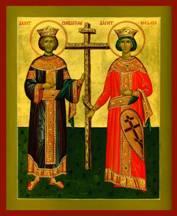
Objectives:
- Students should identify Constantine as Emperor of Rome.
- Students should know “In Hoc Signo Vinces” and what it means.
- Students should know that with the Edict of Milan, Constantine made Christianity legal in the empire, ending persecutions.
Possible Lesson Plan:
- Open with prayer.
- Tell the story of Constantine as follows:
As the cruel Roman Emperor, Diocletian, grew old, he decided that when he died the Empire would be divided into four parts. The northern parts, France and England, were given to Constantius Chlorus. Constantius was a wise and just man; his wife, Helen, was a Christian. They had one son, Constantine. But, Constantius was saddened by the cruelty of the other kings, especially against Christians. He took his army against the wicked King Maxentius. In this battle, Constantius was killed and his son, Constantine, became king.
Constantine was not yet a Christian; he worshipped the gods of Rome. Constantine was at war with the wicked Maxentius. As he was crossing the Moldavian bridge, he saw in the sky a flaming cross. Written beneath this cross were the words in Latin, “In Hoc Signo Vinces,” which means, in English, “In this sign you shall conquer.” He knew that the cross was the sign of the Christians. He decided to give the Christian God a try. He had his soldiers carry a Christian cross into battle and they won! Constantine had defeated Maxentius! He now know that Jesus was the true God. When another of the kings, Galerius, died journeying to Rome, Constantine became ruler of the entire Western Roman Empire. The Arch of Constantine was built in Rome to commemorate his victory. His brother-in-law, Licinius, was ruler of the Eastern Empire. The first act of the two brothers was to issue a new law, the Edict of Milan, which said that Christians and all people could worship freely and build churches. But, soon, Licinius broke their agreement and began to kill Christians again. Constantine took his army and defeated Licinius in battle. Now Constantine was Emperor of the entire Roman Empire.
Constantine never forgot Who made him ruler of the Empire. He built many churches, including the first church of St. Peter in Rome. As a king, Constantine was known for his strong and wise leadership. He built a great army and navy. But, he was never fond of the city of Rome. He moved the capital of the Empire to the city of Byzantium and renamed the city Constantinople. Constantine established the Christian Church with such strength in the Byzantine Empire that the Christian Byzantine Empire stood for hundreds of years after the fall of Rome and the Western Empire. Finally, Constantine died and left his great empire to his three sons. History books have given Constantine the title of “the Great” and the Church also remembers him and his mother Helen as great, saints “equal to the apostles.”
- Discuss for a bit the Roman Empire. Show pictures from a library or history book if possible. How did the people dress? How did they live? What gods did they worship? What kind of houses did they build? Monuments? Can the students name some other emperors? How much of the world did they rule? What is left today of Rome? Be sure the students can say “in hoc signo vinces” and “Edict of Milan”. Even today, in churches, we see “I””H””S” on various articles.
- Play a learning game: Truth or Consequences – Ask the students one by one to answer a question about today’s lesson. If they get the answer wrong, the class will impose a (reasonable) punishment – stand on one foot, do a somersault, quack like a duck, etc. – nothing dangerous, too hard, or that takes too long. Possible questions include:
Who was Constantine’s father?
Who was Constantine’s mother?
Where did Constantine have his vision?
What did he see in his vision?
What words did he receive with his vision in Latin?
What is the English translation of these words?
Who did Constantine defeat to become ruler of the Western Empire?
Who was Constantine’s brother-in-law?
With what law did Christianity become legal?
What city did Constantine make capital of his empire?
- Make Constantine’s
 crown: Use gold tinsel pipe cleaners and purple and white pony beads (glow-in-the-dark beads are even “cooler”). Twist the ends of two pipe cleaners together to make one long one (back and front of crown). On one pipe cleaner string the beads 1P, 5W, 1P, 5W to the end of the pipe cleaner with 1P. Stick a new pipe cleaner through the first purple bead in row one and twist with the other pipe cleaners neatly. String beads 4W, 1P, 4W, then go thru the next purple bead on the first row, repeating all the way down to the end. You’ll have to add another pipe cleaner about half way down to finish. Twist to the other pipe cleaners after going through the last purple bead. Fit to the head of the student by twisting back pipe cleaner to front on other side.
crown: Use gold tinsel pipe cleaners and purple and white pony beads (glow-in-the-dark beads are even “cooler”). Twist the ends of two pipe cleaners together to make one long one (back and front of crown). On one pipe cleaner string the beads 1P, 5W, 1P, 5W to the end of the pipe cleaner with 1P. Stick a new pipe cleaner through the first purple bead in row one and twist with the other pipe cleaners neatly. String beads 4W, 1P, 4W, then go thru the next purple bead on the first row, repeating all the way down to the end. You’ll have to add another pipe cleaner about half way down to finish. Twist to the other pipe cleaners after going through the last purple bead. Fit to the head of the student by twisting back pipe cleaner to front on other side.
- Close with prayer: Lord, let me take my cross up every day to defeat all my enemies in your name.
Elevation of the Cross
THE ELEVATION OF THE CROSS
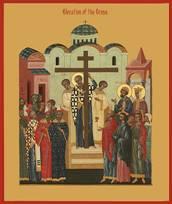 Objectives:
Objectives:
- Students should recognize a cross and how to make the sign of the cross.
- Students should know the story of St. Helen and the finding of the Holy Cross.
3. Why is the cross important to us as Christians?
Possible lesson plan:
- Open with prayer. Practice making the sign of the cross as you pray.
- Tell the story of St. Helen and the finding of the Holy Cross, using the icon as a picture to illustrate the story for the students:
The Empress Helen, mother of the great Emperor Constantine, was traveling to the Holy Land, the land where Jesus had lived and died and risen from the dead. All the palace was in an uproar. The servants prepared food for the journey, packed the clothing, and made everything ready for the royal family to travel. The Empress was a Christian – one who believed that Jesus was the true God. She was going to the Holy Land to find the places and things the Bible told about.
Soon, the royal party – the empress, her ladies, her soldiers, and her servants – reached the Holy Land. The royal ship, with its sails of purple silk trimmed with gold, landed at the port of Joppa on the Mediterranean Sea. There, camels and horses and donkeys waited to carry them inland. The road was hot and dusty; the sun beat down on them. Finally, they reached the city of Jerusalem. They could almost feel the presence of Jesus. These were the very streets He had walked about 300 years before.
Empress Helen had the servants put up silken tents on a hill outside the city. The hill was called Golgotha, a dusty mound with a few bent and twisted old olive trees growing nearby. What was special about this hill? The Bible says that Golgotha was where Jesus was crucified. No one had seen the cross on which the Lord died, but, somewhere on that dusty hill, Empress Helen was sure that she would find three crosses. The Lord had given her many dreams and visions that had started her on this journey. He would surely show her how to complete her task. Helen prayed. Then, she told her men to begin digging, not on top of the hill, but in a little gully to the side. As they dug, the men became more and more excited. Suddenly, one of them found something wooden. It was a cross! Soon, there were three wooden crosses uncovered. But, which one was the cross of Jesus Himself?
The Bishop of Jerusalem, Macarius, suggested a way to find out. He know of a woman who was sick, so sick she was about to die. He had his servants carry the woman out to the hill. The woman was tired and wondered what was happening. Then, the bishop asked the sick woman to touch the first cross; nothing happened. She touched the second cross; nothing happened. Then she touched the third cross; suddenly she was full of energy and life and was well again. Surely this was the true cross of Christ!
The Empress Helen sent word to her son, the Emperor Constantine, that they had found the true cross of Jesus Christ. There was rejoicing in all the Christian Churches. The emperor ordered that a church be built there on the Mount of Olives. He reminded all the people that, wonderful though it was to find the wooden cross on which Jesus was crucified, we do not worship the cross but the Lord who died on it. And so it is to this day.
3. Teach and sing, complete with prostrations:
Before thy cross, we bow down in worship, O Master,
And thy holy resurrection we glorify.
4. Why is the cross so important to us as Christians? Discuss with the students; get their ideas. What happened on the cross? Why did Jesus have to die on the cross? Why was there so much rejoicing at the finding of the cross? Why do we wear crosses to this day, and cross ourselves, and have crosses in and on our churches?
5. Play a learning game: Poses – choose a pose to represent the various people or things in the story:
- Empress Helen: Hands in circle on head as a crown
- Bishop Macarius: Fists forward as if holding staff
- Cross itself: Arms outstretched as in crucifixion
- Sick woman: Lie on floor
Once the students know the poses, at the word “Go” they assume the pose of their choice. Teacher closes eyes and selects one pose. All in that pose are “out”. Play until there is one winner.
6. Cross Seed Mosaic: Take a paper plate. Draw a cross on it. Have available various
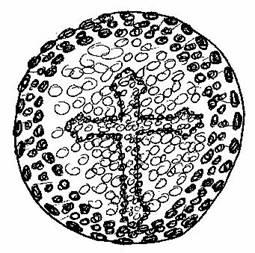 seeds: Lentils, dried peas, barley, black beans, dried corn, etc. to make different colors. Students can decorate the plate and cross with the seeds, outlining and making it beautiful.
seeds: Lentils, dried peas, barley, black beans, dried corn, etc. to make different colors. Students can decorate the plate and cross with the seeds, outlining and making it beautiful.
Alternate craft: Beaded cross. Get 6 Pony Beads, some string or lacing (long for a necklace, short for a zipper pull or keychain), and tiny glue dots. Use the glue dots to hold the 3 middle beads together. Begin with bottom bead in middle of string. Lace both ends thru next bead, then up the triple bead in the middle, and both thru the final bead. Pull tight and tie a nice, thick knot above the top bead to hold it all together. If using plastic lacing, add a glue dot to the knot to be sure it holds.
The cross was found in a clump of basil; so, to this day, we celebrate the feast with basil. It’s winter now, but a good time to plant herbs. Plant some basil for the feast NEXT YEAR! Use any pot and color and glue on the special “pot cover”. Fill with dirt, plant seeds, and put it in the sun, watering regularly. You can plant it outside in the spring or just keep it in a larger pot.
7. Conclude with prayer, again practicing the sign of the cross.
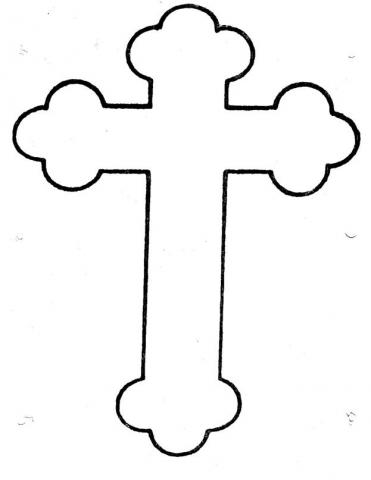
St. Mary of Egypt
ST. MARY OF EGYPT
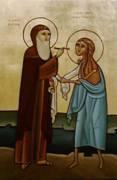 Objectives:
Objectives:
- Students should know who Mary was.
- Students should know the word “repentance”.
- Students should be able to tell the story of her life.
Possible Lesson Plan:
- Open with prayer.
- Tell the story of Mary of Egypt:
Mary was born in Alexandria in the land of Egypt. She was a very beautiful and very rich girl. She didn’t believe in God and said that she could do anything she wanted.
One day, Mary sailed to Jerusalem with her friends looking for fun. Now, it happened to be the time of the feast of the Ascension, and many Christians were going into the Church built over the tomb of Jesus to pray. Mary was curious. What were they doing? She tried to enter the church, but an invisible force pushed her back. She tried again and again, with no luck. She wondered why she could not enter the church. Could it be her sins that were pushing her back?
Suddenly, Mary began to change. She looked at an icon of the Virgin Mary and was ashamed of the way she had been living. She knelt before the icon and cried her heart out. God’s voice came to her and told her to go into the desert beyond the Jordan. At first, life in the desert was hard, remembering all the fun she used to have with her friends and her fine clothes and good food. In the desert, she was hungry and thirsty and had only rags to wear. But the Lord sent her wisdom and peace in her soul.
After fifty years, Mary saw a man walking in the desert. It was a monk, Zossima, who had come to pray. Mary asked Zossima to return the next year on Holy Thursday to give her communion for the first time since her repentance. Then Mary disappeared into the desert.
The next year, Zossima returned as he had promised. He waited on the banks of the river, which was flooded. How would Mary get across? The he saw her on the other shore. Mary prayed and walked across the water! Zossima gave her the beloved communion and Mary prayed the prayer of St. Simeon, “Lord, now lettest thou thy servant depart in peace…” Can you sing this great hymn? Do it now. Mary asked Zossima to return the next year.
The next year Zossima came and found Mary’s body; she was dead. She had written in the sand that she wished to be buried her, in the desert, where she had found the Lord in her heart. Zossima sang the memorial service for Mary, but he was an old man and could not dig the grave. Suddenly a lion came and dug the grave with his claws. Thus, Zossima and the lion buried Mary’s body while her soul went to be with her Lord in heaven.
- Discuss repentance: We use it a lot in church, but what does it mean? To repent is different from just feeling sorry for what we’ve done. It means to turn around and go the other way. Mary felt sorry in Jerusalem. But, her life in the desert was truly a complete turn-around from her former life. Have the students name some things Mary would have had and done in Alexandria; what about in the desert? Be sure the desert list is not all negative – she had peace and the love of God, etc. Now as the students if they have ever done something wrong? Can they tell about it? In what way have they repented? What would be a good way to show their repentance. For example, if they disobeyed their parents and didn’t clean their room, could they go and clean it extra good now and each time from now on? If they fought with their sister or brother, could they do something especially nice for them and give them a hug?
- Make Mary and Zossima bag puppets: Use the pattern for the puppet halves. Glue top of puppet to bottom of small paper bag and mouth part to part below so you can make the bags “talk”. Color the faces. Give Zossima white cotton ball hair and beard. Give Mary long, stringy gray yarn hair. Cut a circle of yellow construction paper and glue behind Mary’s head. Now, can the students, using their own words, reconstruct the scene between Mary and Zossima at their meeting?
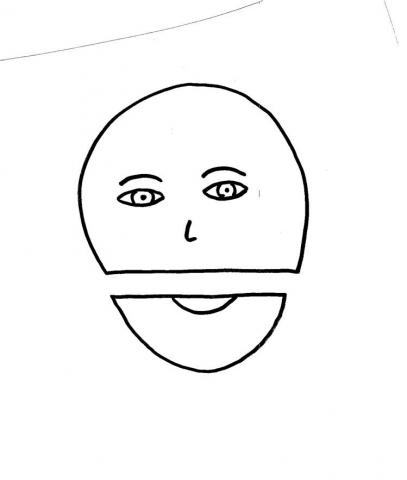
- Close with prayer: Lord, give me true repentance every time I do something wrong.
Canon of Scripture
CANON OF SCRIPTURE
Objectives:
- Students should know how we got our Bible.
- Students should know the word “Canon” and what it means.
- Students should memorize the names of the 4 gospels plus the book of Acts.
Possible Lesson Plan:
- Open with prayer.
- How did we get the Bible? In the early Church, the only Scriptures known were the Old Testament. It was originally written in the language of the Jews, Hebrew, but had long since been translated into Greek as the Septuagint. It was written long before Jesus was born. The Old Testament tells about the creation of the world, God’s chosen people, God’s promises of a Savior, and the history of the Jewish people. Do you remember some of the stories from the Old Testament? Some of the books we memorized 2 years ago? Jesus Himself read from these Scriptures when He taught. This was the only Bible read by the apostles! But, there is debate even about these Scriptures. The Greek translation of the Hebrew Old Testament, the Septuagint, includes some books not included in some of the oldest Hebrew manuscripts. These books, known as the Apocrypha, are recognized by both the Church and the Jewish synagogues as inspired and are included in the Orthodox Study Bible.
In the first days after Pentecost, the apostles taught the people about Jesus. The people memorized the stories and loved hearing them. So, even while the apostles were still alive, collections of stories about Jesus began to be written down. Peter probably supervised the writing of the gospel of Mark. Luke traveled and talked to many people to learn all about Jesus to write his gospel. And, of course, Matthew and John were with Jesus from the start and wrote what they had personally seen and heard. These books are called the gospels and tell about Jesus. They are the first four books of the New Testament.
Luke also traveled with Paul and wrote a book about the history of the early Church. This is called the book of Acts. The apostles traveled to many cities, starting churches all over the world. When you travel, don’t you send letters or postcards to
those you miss at home or in other towns? So, the apostles wrote letters, or epistles, to others of their churches while they were elsewhere. Most were written in Greek. Paul, Peter, John, James, and Jude all wrote letters. In fact, they wrote a lot more letters than are in the New Testament. Some letters may have been fake or lies. But, from earliest times, certain ones of their letters went from church to church, copy by copy, by foot or donkey or horse or camel. Each copy was made by hand – each hand-carried with love to the next town to share with fellow believers. Even the apostles, in their letters, talked about the letters of the other apostles they had read! These letters were especially precious in the days of persecution, when they had to be hidden carefully from the Romans. In fact, during the reign of Diocletian, the Romans sent spies all over the empire and tried to destroy all Christian writings!
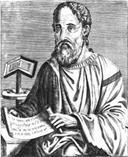 But, by the second century, many of these letters were well-known through the church. Early Christian bishops, Clement and Polycarp and Ignatius (Do you remember the story of Ignatius?), refer to them as being read in the churches. Origen, a great scholar and teacher in Alexandria, had by the year 200 made a list of writings that he considered to be really the work of the apostles. Finally, Constantine became Emperor and Christians were free to read the Scriptures in their churches openly. But, which Scriptures? Constantine gave the great historian Eusebius, who had lived through the persecution of Diocletian, a great order – to produce 50 Bibles. Eusebius carefully studied all the letters and gospels he could find and came up with a list of 27 books for the New Testament, the same 27 books we recognize today. Have you ever heard of the Epistle of Barnabas, or the Gospel of Peter, or the Shepherd of Hermas or the Gospel of Nicodemus? These are all writings rejected by Eusebius, although each was loved in a few cities. Eusebius chose carefully those writings accepted by most of the cities – writings known throughout the early Church to be the true work of an apostle or saint. The first are the gospels (Can you name them?), then the Acts, then lots of epistles (or letters), and finally the Revelation of John (Remember what it was about?). The Council of Carthage in 397 AD formally listed these 27 books as the New Testament.
But, by the second century, many of these letters were well-known through the church. Early Christian bishops, Clement and Polycarp and Ignatius (Do you remember the story of Ignatius?), refer to them as being read in the churches. Origen, a great scholar and teacher in Alexandria, had by the year 200 made a list of writings that he considered to be really the work of the apostles. Finally, Constantine became Emperor and Christians were free to read the Scriptures in their churches openly. But, which Scriptures? Constantine gave the great historian Eusebius, who had lived through the persecution of Diocletian, a great order – to produce 50 Bibles. Eusebius carefully studied all the letters and gospels he could find and came up with a list of 27 books for the New Testament, the same 27 books we recognize today. Have you ever heard of the Epistle of Barnabas, or the Gospel of Peter, or the Shepherd of Hermas or the Gospel of Nicodemus? These are all writings rejected by Eusebius, although each was loved in a few cities. Eusebius chose carefully those writings accepted by most of the cities – writings known throughout the early Church to be the true work of an apostle or saint. The first are the gospels (Can you name them?), then the Acts, then lots of epistles (or letters), and finally the Revelation of John (Remember what it was about?). The Council of Carthage in 397 AD formally listed these 27 books as the New Testament.
Try this quiz; students can use their Orthodox Study Bibles for reference:
There are ____ books in the Old Testament.
The Old Testament was originally written in the ________ language.
The Greek version of the Old Testament is called the _____________.
The Book of ____________ contains beautiful poetry.
The _____ Testament was written before Christ was born.
Books of the Old Testament included in the Septuagint but not in the
Hebrew are called the ______________.
There are _____ books in the New Testament.
Most of the New Testament was originally written in the ____ language.
The ________ tell of the life of Jesus.
The book of ________ tells the history of the early Church.
The ________ are letters.
Some of the writers of the Epistles are ____________________.
The Emperor _____________ finally allowed Christians to read the
Scripture legally.
The list of official books in the Bible is called the _____ of Scripture.
_______________ put together the original list of New Testament books.
The Council of __________ decreed the official canon of Scripture.
- Work on the books of the Bible – Memory work for this week is the books of the Bible. Repeat the word “canon” a few times; this is the list of books that the Church, throughout holy tradition, has accepted as the word of God. Take the students on a tour of their Bibles; can they find the Torah, the History books, the Poetry books, and the Prophets in the Old Testament and the Gospels, the History book (Acts), and the Epistles (or letters) in the New? Try playing Bible relay: Break the class into two teams. Write various Bible references on cards. Place a Bible on the table a few feet in front of each line of students. The first student in each line must find the first reference, then return and tag the next person, who finds the second reference, etc. These “time trials” help the students to learn the books, since looking them up in the Table of Contents is too time-consuming.
- Make Bible flash cards for the students to use to learn the books of the Bible at home. Have each student write each book of the Bible on an index card. (This will take awhile but will be more of a learning experience than having the cards pre-printed on the computer.) Can they put them in order? Try marking paper bags with titles: Torah, Old Testament History, Wisdom, Prophets, Gospels, Church History, Epistles, Apocalypse. Can the students place their index cards in the right bag?
BOOKS OF THE OLD TESTAMENT
(to the tune of the verses of “Jesus Loves Me”)
Genesis, Exodus, Leviticus,
Numbers, Deuteronomy,
Joshua, Judges, Ruth God brings,
Kingdoms 1,2,3, and 4,
Two of Chronicles and Ezras two,
Nehemiah,Tobit, Judith
Esther, Maccabees all three,
Psalms, Job, Proverbs, Ecclesiastes,
Song of Songs and Wisdoms two
Hosea, Amos, Micah, Joel,
Obadiah, Jonah, not all,
Nahum, then comes Habakkuk,
Zephaniah, Haggai,
Zechariah, Malachi
Isaiah, Jeremiah
Baruch and Lamentations, too.
Jeremiah’s Epistle then.
Ezekiel, Daniel, that’s the end,
All of these God’s works foretold
And His promises of old.
BOOKS OF THE NEW TESTAMENT
(to the tune of the ABCs)
Matthew, Mark and Luke and John,
Acts and Romans, Corinthians 2
Galatians, Ephesians, Philippians, Colossians,
1st and 2nd Thessalonians,
1st and 2nd Timothy,
Titus, Philemon, Hebrews, James,
2 of Peter and 3 of John,
Jude and the Revelation.
Now we know the 27 books
Of the New Testament of Christ our Lord.
- Close with prayer: Lord, may I read your Holy Bible every day of my life. Have each member of the class plan a time of day to read the Scriptures and pray.
St. Athanasius and the Creed
ST. ATHANASIUS AND THE CREED
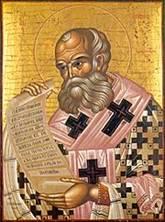
Objectives:
- Students should know the story of St. Athanasius and be able to say his name.
- Students should be able to say the creed.
Possible Lesson Plan:
- Open with prayer.
- Tell the story of St. Athanasius (Have your maps ready to locate Alexandria and Nicea):
Athanasius was born at the end of the third century (How long ago was that?) in the city of Alexandria in Egypt. At that time, Alexandria was an important center of education and learning in the Roman Empire and its bishop an important leader in the Christian Church. One day, the bishop looked out his window and saw some small boys walking back and forth at the seashore. When he asked what they were doing, they said that they have made their friend, Athanasius, their bishop and are following his order to baptize the other children. Athanasius had taught the children all about Jesus and they were ready to follow the Lord! The bishop came to love Athanasius and the boy spent many hours in the bishop’s home reading and studying.
By the time he was 20 years old, Athanasius was writing books about the Lord. He believed that Jesus was truly God as well as truly man. But, another priest in Alexandria, named Arius, believed just the opposite. He believed that Jesus was a “superman” but not really God. He began to tell people that Jesus was a great hero. Even the Emperor Constantine heard of this great disagreement in the Christian Church and was upset by the arguments. So Constantine decided to hold a council of all the bishops. This council was held at Nicea in Asia Minor in 325 AD. Constantine himself was the presiding judge. Athanasius, still a young deacon, spoke to the bishops about the dangers of this new belief that Arius was spreading. Arius also spoke. Even Bishop Nicholas of Smyrna was present to defend true Orthodoxy along with Athanasius. The Council decided against Arius and wrote a creed, or statement of belief, that says, “Jesus Christ…being of one essence with the Father” to end the disagreement.
Athanasius became Bishop of Alexandria in 328 AD. But Arius was still alive and even the Emperor allowed Arius to keep teaching. Then he spread rumors that Athanasius had murdered a man. Athanasius went to Constantinople as a prisoner, but he showed them alive the man he was supposed to have killed! Even so, Athanasius was sent into exile – a prisoner in France for many years. When he finally came home to Alexandria, he again became Bishop. But, when a new Emperor arose who believed with Arius, Athanasius had to escape to Rome. He would try over and over to go back to Alexandria, only to have to flee – finally to the desert. But he never stopped writing about his beloved Jesus. Finally, as an old man, he was able to go home to Alexandria as its beloved bishop.
- Athanasius is called “The Great” by the Church. Why? He defended Jesus against false beliefs for many years. Think a bit about how important it is for Christians to know that Jesus is God. Have the students talk about superman (or spider man, batman, etc.) What are they like? What powers do they have? Are they God? What is different about God? Yes, Jesus was powerful and could walk on water, but His birth, death, and resurrection mean nothing if He was just another superhero! Athanasius would argue that only Jesus the God-man could have died for our sins; only if He were truly God and truly man would the crucifixion have meant anything at all.
- Practice the sign of the cross. The three fingers stand for God the Father, the Son, and the Holy Spirit. And the two fingers down on the palm stand for the 2 natures of Jesus – God and man – who came down to earth. Have the students practice. Do they know what the fingers stand for?
- Work on the creed. The memory work for the next few weeks is the Creed. Sing it together a few times. When do we sing it in liturgy? The Creed is a magnificent document. Even to this day, it is used by the Church to distinguish orthodox (true) belief from heresy. Some groups today use the word Christian or Christ but deny the creed; we know they are not truly Christian. For example, the Christian Scientists, following the teachings of Mary Baker Eddy, do not believe that Jesus was truly God nor in the Trinity. The Jehovah’s Witnesses believe in only God the Father – Jesus was a “superman”. And the Mormons (the Church of Jesus Christ of Latter Day Saints, founded by Joseph Smith) do not believe in the Trinity. All fail the test of the Creed, written by the Council of Nicea in 325 AD! Ask the students, if someone asked you to define your faith as a Christian, what would you answer? The Nicene Creed gives a full and adequate answer, elegant and simple.
- Play a learning game: Creed Bounce. Have a beach ball ready. Sit or stand in a circle on the floor. Begin with the first few words of the Creed. Bounce the ball to a student who continues for another line. He bounces the ball to another student… Do the Creed 2-3 times thru.
- Make a Creed Scroll: Athanasius was Bishop of Alexandria, in Egypt. Egypt was the home of papyrus, the first paper made of plant fibers soaked, pressed together, and dried. Scrolls were made by pasting together squares of papyrus to make a long, thin document that could be rolled up and stored or carried easily. A great improvement over stone tablets! Take some nice paper, preferably one with the fibers showing. We have a bit in the cabinet. Have each student write the Creed on his paper. Roll it up and tie with a ribbon. Have the student keep it with him or in the car to work on the creed! OR print the Creed Coloring book and have students color and take home. Put two of each "segment" on each page and the entire file will print duplex, flip on long side, with 2 books for each printing.
- Alternate Craft Idea: Creed bookmark. See pattern on the next page. Copy back and front in color and laminate or use contact paper to make waterproof.
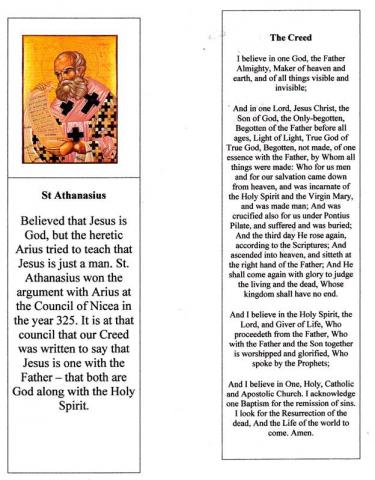
Does the lesson happen to fall right around Nativity? Why not make a "Creed" ornament? Just print on white cardstock, fold, tape or glue together. The Creed is the Church's statement of belief -- about the Father, about Jesus, about the Holy Spirit, and about the Theotokos. But it begins with my own statement, "I believe".
- Close with prayer: Lord, help me to be strong in what I know is true, even when everyone else disagrees with me.
St. John Chrysostom and the Divine Liturgy
ST. JOHN CHRYSOSTOM AND THE DIVINE LITURGY
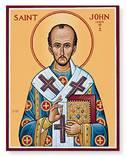 Objectives:
Objectives:
- Students should be able to say the name, St. John Chrysostom, and tell his story.
- Students should know that he wrote the Divine Liturgy we celebrate most Sundays.
Possible Lesson Plan:
- Open with prayer.
- Tell the story of St. John Chrysostom:
St. John Chrysostom was born about 300 years after the time of Christ in the city of Antioch in the land of Syria. (Locate Antioch of Syria on your maps.) His parents, Secounthos and Anthousa, were very rich. They became Christians before John was born, and John was baptized when he was very young. Secounthos died when John was a boy, and Anthousa taught him carefully about Christ Jesus and the Christian life.
When he became a young man, John went to Athens to study in the university there. In Athens, he soon became known for his wonderful preaching. He became famous all through the land. In face, his name “Chrysostom” is not his last name at all but means “Golden-Tongued” and was given to him because of his wonderful speaking. One day, John was telling men who believed in other gods about the Lord Jesus. One of these men, Anthemios, fell down to the ground shaking after denying the true God. John prayed for Anthemios and he was healed. Anthemios and many others of the learned men then became Christians and were baptized.
When John finished his schooling, he returned to Antioch and became a monk. During this time, many people who were sick came to him for prayer and were healed. Some farmers even came to him because they were afraid of a lion which killed many people. John told them to pray to God and gave them a wooden cross to place on the road. The next morning, the lion was found dead in front of the cross. St. John lived in the monastery for four years, performing many miracles and serving as an example of Christian life. He then left the monastery to live alone in the desert a life of prayer. For three years he lived in a cave and studied the Bible. But, John became ill and had to go back to Antioch. He was ordained a deacon and served the Patriarch, St. Meletios, for five years.
When Patriarch Meletios died, the new patriarch, Flavianos, saw a vision telling him to take John to Constantinople and there ordain him a priest. The next day, they left Antioch for Constantinople. As the patriarch was ordaining John, a white dove appeared and sat on John’s head, showing the blessing of the Holy Spirit. (What other time did the Holy Spirit appear as a dove?) John went back to Antioch as a priest. Soon, the Patriarch of Constantinople died and John was named patriarch. He had to be sneaked away from Antioch in a carriage because the people loved him so much they did not want him to go. During John’s time as Patriarch of Constantinople, John continued to preach the Word of God with great wisdom. He also wrote many books of sermons and interpretations, composed hymns, and gave us the Divine Liturgy still celebrated today.
But, John was never afraid to speak out against those who did not live the way of Christ. Because of this, he made many enemies, including the emperor’s wife, Eudoxia, whom he criticized for her greedy and selfish way of life. Finally, she brought a list of lies against John to the bishops and had John sent away. The people tried to stop this, and hundreds of Christians were killed by the empress’s army. As John was unjustly removed from the city, first an earthquake threatened the city, and then the beloved church of Hagia Sophia was destroyed by fire, along with the Senate building. John spent his last four years as a simple priest in the village of Cacussus.
- St. John Chrysostom wrote the Divine Liturgy as we celebrate it most Sunday’s of the year. Explain that this is the special service that we have to worship God. Review the parts of the liturgy; students should be able to chime in with answers as they recognize the things they have heard and sung for years:
- Litany: Here we pray for the whole world. Who else do we pray for? (travelers, prisoners, leaders of our country, bishops, priests, deacons, rain and sun, food to eat, and we especially remember Mary the Theotokos) What do we respond? (Lord have mercy. Grant it, O Lord.)
- Hymns of worship: 1st and 2nd antiphons, troparia and kontakia, Trisagion -- review these words. Try singing the antiphons we use each Sunday.
- Epistle and Gospel: Here we hear God’s word from the Bible. The priest carries out the Gospel and tells us to pay attention to God’s word.
- Cherubic Hymn: God makes us His special guests, along with the seraphim and cherubim, His angels in heaven. The priest uses incense as he prays, reminding us that the prayers go up to God the same way the smoke rises. The priest carries the chalice and discos inthe Great Entrance, while praying for us all!
- Creed: We all recite the creed –review the writing of the creed by the Fathers of the Church in Nicaea under Constantine the Great.
- Preparation for Communion: Review the story of the Last Supper. Here the priest prays for the bread and wine to become the true body and blood of Jesus. We say “Amen” and bow to the altar.
- The Megalynarion: We honor Mary the Theotokos with a special hymn.
- The Lord’s Prayer: Can we say it together? Jesus gave us this prayer Himself.
- Holy Communion: We receive the body and blood of Christ.
- Benediction: The priest blesses us and dismisses us. We all kiss the Cross.
- Play a Liturgy learning game: Pictionary. There are several items used regularly in Liturgy. Review these. Take a trip to the sanctuary to view them, if desired. Then write the name of each on a small slip of paper. Student will draw a slip of paper and try to draw the object on the board while other students guess what he is drawing.
Sanctuary (altar) at the eastern end of the church, why?
Iconostasis: icon screen
Corporal with Antimins: Altar covering used only during communion and
containing relics of the saints
Seven-branched candelabra
Tabernacle (or Ark), where are kept the Communion for the sick and for the
Presanctified liturgy
Gospel Book
Sacramental Fans, representing the Seraphim
Table of Oblation, where the priest prepares the Holy Gifts
Diskos (or Paten): a plate for the bread
Star Cover: to support the veil so it does not touch the bread
Chalice: cup for the wine
Spoon and Sponge and Spear: the spear is used to cut the pieces from the
Prosphora, the spoon to give Communion, and the Sponge to clean
Veils: Covering for chalice and paten
Censer, for incense
- Make a Liturgy Book for each child. They can use these in Liturgy to help them remember the parts of the service. Take 4 pieces of paper and fold in half. Staple all together in the middle. On the front write “My Liturgy Book”. On the first page, print “Litany” and draw some of the things we pray for in the litany – an airplane or car or train or boat, fruit or vegetables, sun, prison bars, red cross for hospital, Orthodox cross for the church. On the next page, print “Hymns” and try some musical notes. Next print “Holy Bible” and draw a picture of the Bible, then “Cherubic Hymn” with an angel to represent the cherubim (Do you remember the various “choirs” of angels from the lesson on Revelation?). Then print “Creed” with a picture of Constantine, or just a crown. “Preparation for Communion” with bread and a chalice follow, then “Megalynarion” with a small picture of Mary (We have lots of these in our old bulletin covers file.). “The Lord’s Prayer” with praying hands would be next, then “Holy Communion” with the chalice and bread again, and finally “Benediction” and a cross to kiss. If drawing these themselves takes too long, use stickers for some. Here are also some pictures that will help.
- OK, too hard? Just print the Liturgy books on the next several pages double-sided, color or draw (can continue DURING Liturgy for the next several weeks, reviewing the lesson as you go, then staple or punch holes and tie with ribbon or add folder cover.
- Close with prayer: Lord, help me to use my tongue to speak only Your words.
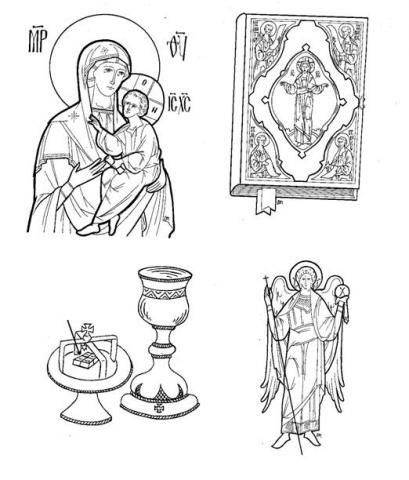
Three Cappodocian Fathers
THE THREE CAPPADOCIAN FATHERS
Objectives:
- For these students, concentrate on St. Gregory of Nyssa – his life and how he served the Lord.
- Students should know that his brother was St. Basil the Great.
- Students should know the word “hierarch” and that it means bishop. Gregory was bishop of Nyssa.
- Students should be able to name the three Cappadocian Fathers: Basil the Great, Gregory Nazianzus the Theologian, and Gregory of Nyssa.
- Students should review from past years that the Three Hierarchs are St. Basil the Great, St. John Chrysostom, and St. Gregory Nazianzus.
Possible Lesson Plan:
- Open with prayer.
- Tell the story of St. Gregory (Have your maps ready to locate Nyssa.):
St. Gregory was born about 300 years after the birth of Christ. He came from a strong Christian family; his brothers, St. Basil the Great and St. Peter of Sebastea, and his sister, St. Macrina, are all remembered today for their holiness. Their parents, Sts. Basil and Emmelia, died when Gregory was very young. Gregory was brought up by his older brother Basil and his sister Macrina. He was taught in the best schools of the day and was especially good at public speaking.
Soon after he finished school, Gregory married a Christian girl named Theosebeia and became a teacher. But, it was not long before he left teaching and became a priest. After several years of faithful work, his brother Basil chose Gregory to become bishop of Nyssa. This was a very difficult job. Many of the people of Nyssa believed the false teachings of a man named Arius and constantly argued with their new bishop. Finally, they told the governor that Gregory had stolen some money, and Bishop Gregory was arrested by the soldiers. He escaped and had to spend many years in hiding until the emperor made him bishop again.
Soon afterward, his brother Basil died. Now Gregory became one of the leading men of the church, standing firm for the true teachings of Jesus against many false teachers. Gregory traveled all over the empire to bring order and discipline into confused churches. He was a leader at the general councils of Antioch and of Constantinople. During his life and after his death, Gregory was recognized as one of the greatest Christian teachers. He wrote several books and letters that we still can read today. Finally, after a long and full life, Gregory, Bishop of Nyssa, joined his brothers and sister with the Lord.
- Do the students remember anything about the lives of the other 2 Cappadocian Fathers: St. Basil the Great (studied when they were in the earliest class) and St. Gregory Nazianzus (studied when they were in the last class)? St. Basil was known best for his organization of monastic life, his liturgy (When do we celebrate it?), his strong defense against the teachings of Arius, and his care for the poor, sick, and orphans. He was bishop of Caesarea. Gregory Nazianzus is also known as Gregory the Theologian. He was friend of Basil and priest of Nazianzus after the death of his father. Basil appointed him Bishop of Sasima. Together with St. Gregory of Nyssa, the three are called the Cappadocian Fathers because they were from the region of Cappadocia. Locate it in Asia Minor on your maps. St. Basil and St. Gregory Nazianzus, along with St. John Chrysostom (What do the students remember from last week’s lesson?), are also known as the “Three Hierarchs” – what is a hierarch? (bishop) These men were “theologians”; what is a theologian? They thought deeply about their faith and taught and wrote mightily.
4. Play a learning game: Mystery Pictures. Have each student draw a picture of one of the hierarchs. Include enough detail to distinguish from the other three. Have each hold up his picture; can the others identify the bishop? Which are members of the group known to the church as the Three Hierarchs? Which are the Three Cappodocian Fathers?
- Make Bible Bookends: Take a brick for each child. Spray paint it (your choice of color) or leave it bare; glue a piece of felt on one small end. Color the pictures of each of the “Cappadocian Fathers” – St. Basil, St. Gregory Nazianzus, and St. Gregory of Nyssa, the brother of St. Basil – and of the Three Hierarchs – St. Basil, St. Gregory, and St. John Chrysostom. Repeat the four names until the students can say them and identify them as the Three Cappadocian Fathers and the Three Hierarchs. Cut out and glue one on each
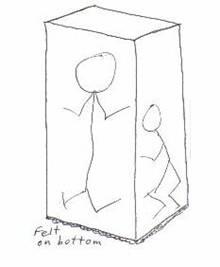 of three sides of the brick. These make nice bookends or a doorstop.
of three sides of the brick. These make nice bookends or a doorstop.
- Close with prayer: Lord, give me the courage of St. Gregory whenever I face evil and have to stand up for good.
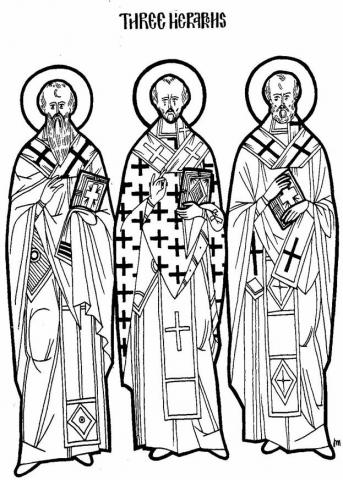
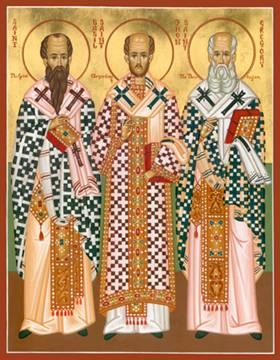
Ecumenical Councils
THE SEVEN ECUMENICAL COUNCILS
Objectives:
- At the end of this two-lesson cycle, students should be able to name each of the seven councils, its major players, and the major decisions reached.
- Students should understand the concilliar process for major theological decision-making in the Church and its purpose in safeguarding orthodoxy for all of us.
Possible Lesson Plan:
- Open with prayer each week. The weeks will not be separated here – the same teacher will continue for both weeks, breaking up the lesson as needed by time constraints.
First review the two councils already studied: the Council of Jerusalem in the first century and the Council of Nicea in 325 AD. Who presided over each? Who was present? What was decided? Do Christians always agree about everything? Even as early as the first century there was disagreement – but one Church.
- Now present the rest of the Councils:
|
Place |
Date |
Personalities |
Major Decisions |
|
1.Nicea |
325 |
St. Athanasius St. Nicholas Emperor Constantine Arius |
Condemned the Arian heresy, which taught that Christ was not truly God. Proclaimed first part of Creed. Established the date of Pascha. |
|
2.Constantinople |
381 |
Emperor Theodosios St.Gregory Theologian St. Gregory of Nyssa |
Defined the teaching on the Holy Trinity, against the heresy of Macedonius, who said the Holy Spirit was inferior to the Father and the Son Completed the Creed. Declared the Bishop of Constantinople second only to the Bishop of Rome because Constantinople is New Rome |
|
3.Ephesus |
431 |
Emp. Theodosius II St. Cyril of Alexandria Nestorius |
Defined the doctrine about the Theotokos against the heresy of Nestorius who said she was only “Christotokos”, splitting Jesus into two separate natures. Declared text of Creed finished and Forbade any future changes in it! |
|
4.Chalcedon |
451 |
Eutyches Emperor Marcian Leo the Great of Rome |
Condemned heresy of the Monophysites, led by a monk named Eutyches, who said Christ was only God and not Man, also. |
|
5.Constantinople |
533 |
Emperor Justinian |
Stated again teaching about 2 natures of Christ and condemned both the Monophysites and the Nestorian teachings of Bishops Theodore of Mopsuestia, Theodoret of Cyrus, and Ibas of Edessa. |
|
6.Constantinople |
670 |
|
Condemned the teachings of “Monothe- litism, which said Jesus’s divine nature made all the decisions and His human nature carried them out – another form of Monophysitism. |
|
7.Nicea |
787 |
Empress Irene |
“Icons are to be venerated; God alone is to be served in faith.” |
- The Ecumenical councils involved all the bishops of the Church, not just a chosen few. As early as the 1st century, Christians disagreed about various issues. But, they could remain one united Church, as Jesus Himself wanted by submitting the important decisions to all the bishops together. One man might be led astray; most of those branded heretics (What’s a heretic?) were men who made an honest mistake. But, the Holy Spirit has protected the true faith of the Church through the decisions made by all its bishops together. This is all part of holy Tradition; the teachings of the Church fathers and the Church herself, helping us interpret the Scriptures. No Scripture is of individual interpretation; we study the councils and the Church Fathers to help us to correctly understand all things.
- Historical background: Each of these councils did not occur in a vacuum. What was happening in the world and in the Church at the time of each council? Be sure to have maps handy for discussion of the various cities and nations.
1st Council: Constantine the Great had just united the Empire, made Christianity legal, and moved the capital to Constantinople. But he found the Church involved in a huge dispute caused by the teachings of a priest named Arius. The Emperor himself called the Council and presided over it in order to reunite His new Church.
2nd Council: After the death of Constantine, his son Constantius tried to bring back Arianism,and, after Constantius, Emperor Julian (the Apostate) tried actually to bring back paganism! Two brothers followed, Valens in the East and Valentinian in the West. Valens was an Arian, Valentinian Orthodox. Finally, Emperor Theodosios declared Christianity to be the official religion of the Empire. He found the Church’s disputes dividing his empire. He called the 2nd Council in Constantinople to try to confirm the Nicene Creed in the face of the teachings of Macedonius, who was teaching that the Holy Spirit was inferior to the Father and the Son, a new heresy. He is known as Theodosios the Great.
Empire. He found the Church’s disputes dividing his empire. He called the 2nd Council in Constantinople to try to confirm the Nicene Creed in the face of the teachings of Macedonius, who was teaching that the Holy Spirit was inferior to the Father and the Son, a new heresy. He is known as Theodosios the Great.
3rd Council: In trying to stamp out Arian teachings, Bishop Apollinarius of Laodicea said Christ was really God and only needed a body to appear to men. This was called Apollinarianism. One step further – Bishop Nestorius of Constantinople said that, in that case, Mary wasn’t the mother of His divine (and more important) nature, she was only the mother of His body – Christotokos instead of Theotokos. Bishop Cyril of Alexandria vehemently opposed this interpretation. Emperor Theodosius II called the 3rd Council to settle this issue. The heresies of both Apollinarius and Nestorius were condemned.
issue. The heresies of both Apollinarius and Nestorius were condemned.
4th Council: Now the school of Alexandria, in a reaction to the Nestorians, decided that the divine nature of Christ was His only nature. The major proponent of this idea was a monk named Eutyches.This heresy was called Monophysitism (“mono” meaning “one” and “phys” meaning “nature”). The Bishop of Rome, Leo the Great, asked the Emperor Marcian to call yet another council. But, even after the council at Chalcedon condemned Monophysitism, Jerusalem, Antioch, and Alexandria continued to support the one nature of Christ. To this day, the Armenian, Coptic (Egyptian), and several smaller Churches remain Monophysite.
5th Council: A series of weak emperors followed and Rome fell to the barbarians. Finally, in 527 AD Justinian took the throne. He is known as Justinian the Great and succeeded in conquering back large areas of the Western Empire and uniting the Church. He called the 5th Council in hopes of ending once and for all the Monophysite and Nestorian controversies. But, as noted above, a few churches, the largest of which was Alexandria in Egypt, refused to give up their cherished beliefs.
6th Council: After Justinian came a series of weak Emperors, leading to a dangerous situation with the Persians on the East. They saw a potential target in the weakened empire with small army, bankrupt treasury, and poor government. They captured Antioch and Jerusalem; even the cross found by Helen was taken back to Persia. Then they took Alexandria and Egypt. They were at the doors of Constantinople itself. Emperor Heraclius took the throne; he was popular and a strong ruler and general. He defeated the Persians near the old city of Ninevah (Remember Ninevah, capital of Assyria, from the story of Jonah?) and all lands were given back. The cross made a triumphal reentry into Jerusalem in 630 AD. The 6th Council was held to decide on the fate of a heresy called “Monothelitism”, an offshoot of Monophysitism, which was condemned and disappeared.
7th Council: This council gets its own lesson later; just learn the bare details for listing purposes for now.
- For a craft and learning game, make a Question and Answer Scope: Take a cardboard gift box about 9x12x2 inches. In the lid cut 2 3-inch windows about 4 inches apart. Print “Question” over the left and “Answer” over the right. Put the lid on the box and poke 2 holes with a pencil through each side, lined up carefully so you can put dowels through. On a piece of 4-5-inch adding machine tape, carefully trace pairs of squares exactly matching the spacing on the windows. Print pairs of Questions/Answers in the boxes. Tape one end of the paper to each dowel and roll the whole thing up onto the right dowel. Advance the paper by turning the left dowel to see first question and then answer. Sample questions/answers?
Where was the First Ecumenical Council held? Nicea
Who called the First Ecumenical Council? Constantine
Whose teachings were condemned at the 1st Council? Arius
Which Council set the date of Pascha? First
Who tried to lead the Empire back to paganism? Julian the Apostate
Who made Christianity the official religion of the Empire? Theodosios the Great
Who said the Holy Spirit was inferior to the Father and Son? Macedonius
Who called the Second Ecumenical Council? Theodosios the Great
Where was the Second Council held? Constantinople
What was the New Rome? Constantinople
Which Council proclaimed the Patriarch of Constantinople Second
second only to Rome in importance?
Who called Mary “Christotokos”? Nestorius
Which Bishop opposed Nestorius at the 3rd Council? Cyril of Alexandria
Where was the Third Ecumenical Council held? Ephesus
Who did the 3rd Council proclaim that Mary is? Theotokos
Which heresy taught that Jesus was only divine? Monophysitism
Which city was the center of the Monophysite heresy? Alexandria, Egypt
Where was the 4th Council held? Chalcedon
What heresy was condemned by the 4th Council? Monophysitism
Who called the 5th Ecumenical Council? Justinian the Great
Where was the 5th Council held? Constantinople
Which two heresies were condemned by the 5th Council? Nestorian/Monophysite
Name two national churches that are Monophysite? Egypt, Armenia
Who stole the Holy Cross from Jerusalem? Persians
What Emperor defeated the Persians? Heraclius
What heresy states that Jesus’s divine nature makes all the Monothelitism
decisions and his human nature just carries them out?
Where was the 6th Ecumenical Council held? Constantinople
What heresy was condemned by the 6th Council? Monothelitism
Who called the 7th Ecumenical Council? Empress Irene
Where was the 7th Council held? Nicea
What veneration was upheld by the 7th Council? Icons

- Close with prayer: Lord, give me the wisdom to understand Your true nature thru the guidance of the Ecumenical Councils.
Fall of Rome
FALL OF ROME
Objectives:
- Students should know that the capital of the Western Empire was the city of Rome.
- Students should know the story of St. Leo, bishop of Rome, and Attila the Hun.
- Students should know the name of the new capital of the Roman Empire, Constantinople.
- Students should be able to name the original 5 Patriarchates.
Possible Lesson Plan:
- Open with prayer.
- Tell the story of the fall of Rome; follow the movements of the tribes on your maps:
Do you remember the Emperor Constantine? He founded a new city, named for himself, Constantinople and moved the capital of the Roman Empire to his new city, far to the east of Rome. The new city was Christian from the start, full of churches. Councils were held there.
Far to the west, in Rome, things were not going so well. Many wild tribes lived to thenorth. They were fierce warriors and knew nothing of Christianity or the great Roman cities and culture. They were called “barbarians” by the Romans because they didn’t even speak L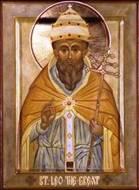 atin or Greek. They lived in little villages and tribes. But, they wanted more and more land. First came the Visigoths out of Germany under King Alaric; they marched into Rome, looted everything in sight, and left. Another of these tribes was called the Huns; their chief was Attila the Hun. They were wild and fierce and rode little, hairy ponies. Attila moved his army down Italy toward Rome itself. They burned and destroyed everything in their way. Finally they were at the gates of Rome. The bishop of Rome in that day was named Leo I (the first). Leo means “lion” but this Leo was not a soldier or a fighting man. But he wanted to save his city and his people. He went out the gates of the city, dressed in his gorgeous robes, with all the bishops and priests. He carried no shield or sword or spear. Would Attila and his men slaughter them like lambs before the wolves? Attila and Leo met outside the walls of Rome. Then, Attila and his army turned around and left Italy – marched away without even entering the city or killing anyone. Leo may not have been a fighting man, but he had the courage of a lion!
atin or Greek. They lived in little villages and tribes. But, they wanted more and more land. First came the Visigoths out of Germany under King Alaric; they marched into Rome, looted everything in sight, and left. Another of these tribes was called the Huns; their chief was Attila the Hun. They were wild and fierce and rode little, hairy ponies. Attila moved his army down Italy toward Rome itself. They burned and destroyed everything in their way. Finally they were at the gates of Rome. The bishop of Rome in that day was named Leo I (the first). Leo means “lion” but this Leo was not a soldier or a fighting man. But he wanted to save his city and his people. He went out the gates of the city, dressed in his gorgeous robes, with all the bishops and priests. He carried no shield or sword or spear. Would Attila and his men slaughter them like lambs before the wolves? Attila and Leo met outside the walls of Rome. Then, Attila and his army turned around and left Italy – marched away without even entering the city or killing anyone. Leo may not have been a fighting man, but he had the courage of a lion!
Soon after, the Vandals, another wild tribe, captured northern Africa. A man named Augustine was Bishop of the city of Hippo at this time. Augustine had been a great teacher and writer of the western Church. But, Augustine was old and ill and died while the Vandals were attacking the city. They sailed up the Tiber River to Rome. They captured the city and stole all its treasures! The Angles and Saxons took Britain; it is “Angle-land” to this day. Then another tribe called the Teutons divided up the empire. Just like Humpty Dumpty, Rome had a great fall – broken into many pieces by the barbarian tribes and never to be put back together again. Each tribe had its different customs and wanted to rule its land in its own way. The last Emperor was named Romulus Augustulus. Old Rome was beaten. It was the year 476 AD. The common language, coinage, communications, mail service – all disappeared in the West. Each small area became a tribal state. A new culture developed, with each lord ruling his own fiefdom from his own castle, protected by knights on horseback. Only in the Church was the Roman culture preserved; the monks wrote the Scriptures in Latin and taught in monasteries. The Bishop of Rome, the only Patriarch in the West, became the only central figure in a sea of small lordships. Under Leo the Great and Gregory I, the Bishops of Rome became known in the west as Pope, or Father. Small kings and lords turned to Rome for decisions.
Meanwhile, The great Patriarchiates of the East – Constantinople, Jerusalem, Antioch, and Alexandria – were little affected by the fall of the Western Empire. The Empire in the East, with its capital in the great city of Constantinople, would continue for another thousand years.
- Look a bit at medieval life in Western Europe after the fall of Rome: Show here some pictures of medieval culture – knights, King Arthur, castles, etc. Movies and books make this life in the “Middle Ages” seem very romantic. But, castles are cold and drafty. People were dirty and unwashed. Food was often scarce; the serfs who grew the food were little more than slaves. Most people could not read or write. These were truly the “Dark Ages” after the glory of Rome.
- Play a learning game: Musical Bridge. While singing “Roman law is falling down…”, students go under the bridge one by one. The one caught has to answer a question about today’s lesson or he is “out”. Sample questions:
Who was King of the Visigoths?
To what city did Constantine move his capital?
Who was leader of the Huns?
Which bishop saved Rome from Attila the Hun?
Which tribes captured Britain?
Who was last Emperor of Rome?
When did Rome fall?
The Bishop of Rome became known as the what?
Name the 5 great patriarchiates of the early Church.
- Make a Flannel Board pizza box: Take a pizza box; most stores will give these to you. Glue light blue felt on the inside back; add cotton ball clouds in the sky and green felt grass along the bottom. Make a gray felt wall and draw stones with a marker; this can sit above the grass. Have students draw Leo in his bishop’s robes, Attila the Hun, and Attila’s horse of construction paper. Color and cut out. Glue strips of felt on the back of each figure. Can you tell the story?
Too complex? Print the figures on cardstock, color, cut out, mount on popsicle sticks and print the Roman Gate background for a "puppet show".
Still too much? How about print the one page on cardstock with the two IN the city gates. Color the two figures. Carefully cut out each archway, leaving the feet of the saint and Attila attached to the cobblestones. Cut out the figures from the archway and toss the rest of the archway. Now fold at the bottom of the wall up to make backdrop, fold up figures up in front of the wall, and you have a 3-D “card”. Glue back onto light blue construction paper for sky behind the now-blank archways.
7. Close with prayer: Lord, help me to trust You whenever someone is mean and nasty.
Justinian and the Byzantine Empire
THE BYZANTINE EMPIRE UNDER JUSTINIAN
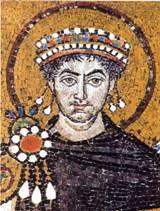
Objectives:
- Students should know the name of the Byzantine Empire and its capital, Constantinople.
- Students should be able to name Justinian as a wise Emperor and list 2-3 of his accomplishments.
Possible Lesson Plan:
- Open with prayer.
- Tell the story of the Byzantine Emperor and Justinian:
About 50 years after the fall of Rome, Justinian became emperor in the East. In this day, Constantinople was the greatest city in the world. The waters around the city were filled with boats; it had high walls to protect it from enemies. People came from all over the world to see the beautiful city and study in its many famous schools and worship in its churches. Justinian saw his city as the Second Rome, greater and finer than Rome ever was.
Justinian also began to collect all the laws of his land. Until this time, each city and state had its own rules and judges. Justinian sent wise lawyers throughout the land and gathered all these laws. They chose the best from each city and wrote a law that would be true throughout the land, the Code of Justinian.
Justinian wanted to take back the lands of the west that had been lost to the barbarians. He first sent his mighty army against the Vandals in North Africa. He took back northern Africa and went from there to Italy and southern Spain. His empire went around the Mediterranean, although he never retook France or England. Review the map on the next page to see the extent of Justinian’s empire.
Justinian also had architects throughout his empire build beautiful churches. The greatest of these was Hagia Sophia, the Church of the Holy Wisdom, in Constantinople. This magnificent church is topped with a huge dome. Artists painted beautiful icons and worked mosaics of tiny pieces of stone and glass. A mosaic could cover the entire wall of a church or monastery. Frescoes were painted in wet plaster right onto the walls of churches. Goldsmiths made beautiful jewelry set with precious stones. The Byzantine Empire became the art and cultural capital of the world.
- Get a book from the library and show some pictures of Hagia Sophia and Constantinople (now called Istanbul). Look at pictures of the beautiful mosaic work in Byzantine style – e.g. St. Mark’s in Venice. Do you see how, with the different colors and background fitted together, a beautiful design or picture can be made? Also look a bit at the basilica style of architecture that flourished in Constantinople. The nave was shaped as a square or rectangle. At one end was the door; at the other a curved projection for the altar. One or more domes crowned the church. Some were in the shape of a cross.
- Play a learning game: Final Jeopardy. Print the answers, each on one card. Give each student a pad of paper and a pencil. Show the cards one at a time; students have about 1 minute to write a question to go with the answer. Sample answers:
Justinian
Hagia Sophia
Mosaic
Code of Justinian
- Make a real mosaic cross trivet: First make the base of Popsicle sticks; lay 2 on the table about 3 inches apart and parallel. Cover top of each with glue. Lay others perpendicular from one end to the other to make a smooth work surface. Now cover your base with glue. Take small colored pieces of broken tile (we have lots of this) or small tiles and shape a cross or other picture. Fill in the rest of the square with white tiles. After it dries, spread grout in the cracks; wipe with damp cloth to get film of grout off the tiles before it dries. These can be used for years as a small piece of Byzantine beauty.
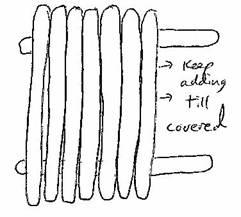
- Close with prayer: Lord, give me a love of the beauty of Your Church as Justinian had.
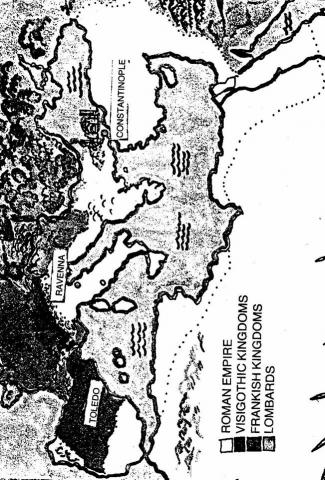
Rise of Islam
RISE OF ISLAM

Objectives:
- Students should be able to name Mohammed as the founder of Islam.
- Students should be able to name “Allah” as the god of Islam.
- Students should know that the book of Islam is called the “Koran”.
- Students should know that followers of Mohammed are called Moslems (or Muslims).
Possible Lesson Plan:
- Open with prayer.
- Tell the story of Mohammed – have pictures of deserts and camels to show:
In the world of the Arabs in northern Africa, a world of camels and deserts, there arose a new teacher. His name was Mohammed. Mohammed was born in the city of Mecca about 600 years after the time of Jesus. He was just a poor camel driver, a servant of a wealthy Arabian lady. The lady fell in love with the servant and they were married. And for many years, the camel driver and his wife lived a quiet life in the town of Mecca. Then, when he was forty years old, Mohammed thought that an angel told him that he should write a new book of teachings about a god he called Allah. He called his book the Koran. Mohammed did not believe that Jesus was the Son of God or that Jesus rose from the dead. In fact, Mohammed believed that he himself was greater and wiser than Jesus! His wife believed Mohammed and became his first follower.
At first, the Arabic people laughed at Mohammed and plotted to get rid of Mohammed. But, Mohammed heard of the plot to kill him, and ran away with his wife and friends. He fled to the town of Medina. The word for “flight” in Arabic is “hegira”; his journey is called the “Hegira” by his followers to this day. For awhile Mohammed taught his new ideas in the city of Medina. He called his new religion Islam and his followers were called Moslems. But soon, Mohammed was not happy to have only the followers who liked his new teachings. He told all of his followers that they would go right to heaven if they were killed following him in battle. They began to force people in Arabia and in other lands to become Moslems or die. Soon, Mohammed and his followers conquered all of Arabia. Mohammed died, but his followers continued to fight wars to conquer lands for their new ideas. They traveled to Persia, to all of northern Africa, to Spain and to France, conquering the Christian lands, until they were stopped in France by the great warrior, Charles the Hammer, at the Battle of Tours. They even conquered Jerusalem and the Holy Land where Jesus had taught and lived! Soon they were at the doorstep of Constantinople, the capital of the great Christian Byzantine Empire built by the Emperor Constantine 400 years before.
For many years the Arabic followers of Mohammed tried to conquer Constantinople. Battle after battle was fought. The people of Constantinople poured boiling oil on the attacking Moslems. Finally, Emperor Leo III defeated the Moslems in 717 AD and made them flee behind the mountains. They did not attack Constantinople again for hundreds of years. Christians were safe to worship the Lord in the lands of the Byzantine Empire again.
- Who were the Arabs? Remind the students of the story of Abraham, and his sons Ishmael and Isaac. Look at the pictures in their picture Bibles and retell the story. The Arabs were the great-great-great-great…grandchildren of Ishmael, who fled with his mother Hagar into the desert. The children of Isaac became what people? (the Jews or Hebrews) Look at pictures of Arabic life – of camels, tents, deserts.
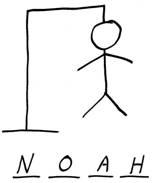 Play a learning game: Hangman – Choose some important words from today’s lesson. Draw a gallows with little lines under it for each letter of the word. Students take turns guessing a letter that might be in the word you have chosen. If the letter is in the word, write it on the correct line. If not, draw a body part. Will the man get hanged before the word is uncoded? Some potential words:
Play a learning game: Hangman – Choose some important words from today’s lesson. Draw a gallows with little lines under it for each letter of the word. Students take turns guessing a letter that might be in the word you have chosen. If the letter is in the word, write it on the correct line. If not, draw a body part. Will the man get hanged before the word is uncoded? Some potential words:
Mohammed Mecca Moslem
Medina Islam Hegira
- Make a Salt Map: Mix salt dough. Color some blue (for water), some light yellow (for Moslem lands), and some green or red (for Christian lands). Take the map on the next page. Glue onto a firm base – piece of cardboard, lid of box, Styrofoam plate. Have students fill in outlines with dough, reviewing all the time what the various geographical features are. Where is the Nile River? Where is Arabia? Put little flags on toothpicks to mark Mecca and Medina, Constantinople and Rome.
- Close with prayer: Lord, help me not to be led away from You by false teachers with new ideas.
Triumph of Orthodoxy
SUNDAY OF ORTHODOXY/ST. JOHN OF DAMASCUS
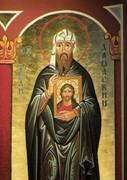 Objectives:
Objectives:
- Students should know that on “Sunday of Orthodoxy” we celebrate the return of the icons to the church.
- Students should be able to define icon and iconclasm.
- Students should know the roles of Empress Irene, Empress Theodosia, and St. John of Damascus in the defeat of iconoclasm.
- Students should know that the 7th Ecumenical Council condemned iconoclasm.
Possible Lesson Plan:
- Open with prayer.
- Tell the story of the Sunday of Orthodoxy:
From its earliest days, Christians made pictures of Jesus, Mary, and important events in Christian history. They drew them on the walls of their tombs, deep in the catacombs under the city of Rome. They drew on the walls of their churches and monasteries. Most people could not read in those days. They did not worship these pictures but used them as “windows to heaven” – to remember the life of Jesus, His teachings, and the lives and teachings of His holy ones, the saints.
But, there came a day about 700 years after the time of Jesus, when a wicked emperor in Constantinople, another Leo, decided to get rid of the icons. He, and later his son, another Constantine, burned the monasteries and killed the monks and looted the churches, trying to destroy all the icons. Icons were hidden to keep them safe.
At this time, there lived in Damascus, a city under the rule of an Arab caliph (or king), a man named John; we know him now as John of Damascus. John was wise and charming; soon he was the caliph’s second-in-command. The caliph was a Moslem, but John was a Christian. John taught and wrote about his love of icons. Emperor Leo did not like this and tried to have John killed. He told lies to the caliph, saying John was going to betray him to the Greeks, and the caliph believed Leo. He had John’s hand cut off. John prayed and his hand was healed! Then John left the palace and went to live in a monastery. There he wrote many hymns and prayers and even invented the series of eight tones for singing we use today in church.
Finally, the Empress Irene called for a council of the bishops. This was the seventh and last church council. The church stood firmly for bringing the icons back! But, the emperors were still opposed. Finally, the Empress Theodosia brought the icons back into the churches. There was such rejoicing. And, to this day, we celebrate the return of the icons with a great procession of icons on the “Sunday of Orthodoxy”.
- Discuss icons: What are they? Let the students discuss a bit. A display of icons or pictures of famous icons will help. Does the student have a favorite icon? How are they different from other pictures? How do we venerate an icon? (practice kissing and making the sign of the cross)What is the difference between veneration and worhip? Where do we put an icon? Does the student have an icon corner in his home? In his room? Maybe this would be a good time to start. Take an icon of a feast and show how it tells the story of the feast. Could someone learn this story even if he couldn’t read? Do any of the students remember how we celebrate the Triumph of Orthodoxy? Have they marched with the priests and others around the church carrying their icons? Use our study sheet to learn how to identify the type of saint depicted in each icon:
- Play a learning game: The Big Step – Line the students up at one end of the classroom; teacher at the other. Each student in turn gets to answer a question from today’s lesson; if successful, he moves one step toward the teacher. If unsuccessful, the question goes to the next student. First student to reach the teacher is the winner.
Sample questions:
Who defended icons to the Arab caliph?
Where did John live?
Which emperor began the destruction of icons?
Who called the 7th Ecumenical Council?
Where was the 7th Council held?
What heresy was condemned at the 7th Council?
Which Empress led the Triumph of Orthodoxy?
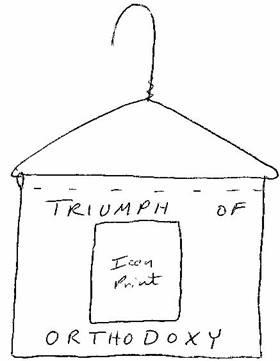 Make a Triumph of Orthodoxy Banner: Take a piece of felt. Staple one end over a wire hanger. Glue on an icon print; we have a vast array of old bulletin covers. Write with magic marker or felt letters “Triumph of Orthodoxy”.
Make a Triumph of Orthodoxy Banner: Take a piece of felt. Staple one end over a wire hanger. Glue on an icon print; we have a vast array of old bulletin covers. Write with magic marker or felt letters “Triumph of Orthodoxy”.
- Close with prayer: Stand before your class icons and venerate first, then pray, Lord, may I honor Your life and Your Mother and all Your Saints each day of my life.
Monasticism: St. Anthony the Great
MONASTICISM/ST. ANTHONY THE GREAT
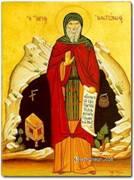
Objectives:
- Students should be able to say the word “monasticism” and to know a little about the life of a monk.
- Students should be able to tell the story of St. Anthony.
- Students should know that St. Anthony is known as the father of monasticism.
Possible Lesson Plan:
- Open with prayer.
2. Tell the story of St. Anthony the Great:
About 250 years after the time of Jesus, a young man in Egypt named Anthony listened to the Gospel from Matthew 19:16-26. Reread it now. Anthony heard Jesus’s words to the rich young ruler. His parents had died; he cared for his younger sister. He was very rich. The words of Jesus spoke to Anthony. He sold his riches, found his sister a Christian home, and went off to the desert to live in a cave. There he spent his days and nights in prayer and Bible study. He ate little food – once every day or two or four. He had many battles with demons. He even got real bruises fighting them. Do you remember Jesus’s battle with the devil after His baptism? Finally, after many years, a light shone through the roof of the cave; from then on his pain was gone and so were the demons. Anthony thanked God for the strength He had given him.
He decided to go even farther from other men to be alone with God. He found an old fort on the banks of the Nile. He continued in fasting and prayer. Anthony thought he would never see another human being again. (Remember the story of Mary of Egypt?) But, after twenty years, other men began to seek out this holy hermit in the desert. They began to leave the cities to seek God alone; they became known as monks from the Greek word for alone. Each lived in a cave or grotto alone; only occasionally would they come together for prayer. Many came to Anthony to live near him and learn from his teachings and example. Because of this, Anthony is known as the Father of Monasticism.
As Anthony grew closer to God, people would come to him for prayer. A ruler in Egypt was healed of blindness; a girl who was paralyzed was healed. His wisdom was so well-known that Emperor Constantine the Great wrote to Anthony for advice. Anthony died in 356 AD. He asked the other monks to bury him secretly; they did, and his resting place is unknown to this day!
3. Discuss monastic life: What is a monk? How does a monk live? Some live alone as hermits or “anchorites” and some in communities called monasteries. St. Anthony had a group of other hermits living around him; another Egyptian named Pachomius began the first monastery where monks live in a large house and pray, study, and work together. St. Basil wrote the set of rules governing life in a monastery that is followed to this day. Ask the students what a typical day in their lives is like – what do they do, eat, wear, type of home, etc. Now take a monk in a monastery and contrast each aspect. Then a hermit. Quite a difference! There are famous monasteries to this day – St. Catherine’s Mt. Sinai (What happened here?) and many on Mt. Athos, an island off the coast of Greece. Would you want to be a monk (or nun)? Are you willing to give up everything for Jesus as Anthony did?
- Play a learning game: Try to sort these descriptions into the right type of monastic
life – hermitage or monastery or both:
Lives alone Lives in a group Follower of Pachomius
Fasts frequently Prays frequently Follows St. Basil’s rules
Works with other monks Eats with other monks Owns almost nothing
Lives in a cave Follower of St. Anthony Reads Bible frequently
- Make St. Anthony’s Empty Treasure Box: Take Popsicle sticks. Lay two on a plate, about 3 inches apart, and cover top surface with glue. Lay a row of perpendicular sticks across the two to make a smooth floor for the bottom of the box, the same way you did for the mosaic. Now glue 2 sticks parallel at the edge of the bottom. Put glue on the ends of these sticks and add 2 sticks perpendicular to the first two and parallel to each other at the other edges of the bottom. Keep adding until your box is the height you want. Can be spray painted. Or, make another bottom for a top. Glue a small icon of St. Anthony to the top. It’s empty now; St. Anthony owned nothing. What treasures will you put in it?
- Close with prayer: Lord, I ask St. Anthony to pray for me that I will grow closer to You every day.
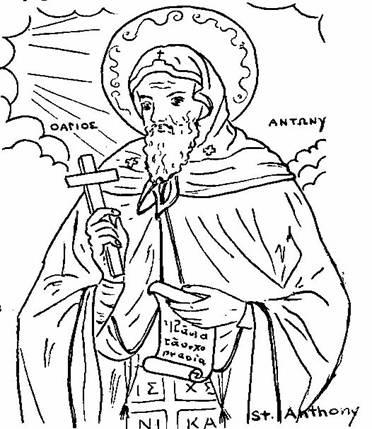
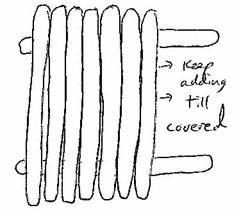
Sts. Cyril and Methodius/Baptism of Russia
ST. CYRIL AND METHODIUS/BAPTISM OF RUS
Objectives:
- Students should know the names Cyril and Methodius and that they told the people of Rus about Jesus.
- Students should know the names of King Vladimir and Queen Olga, the first Christian rulers of Rus.
- Students should know that the gospel spread from the land of Rus, now Ukraine, to Belarus and far north to Russia.
Possible Lesson Plan:
- Open with prayer.
- Tell the story of the Baptism of Rus:
In the city of Thessalonica lived two brothers named Constantine and Methodius. Can you say their names? Practice a few times. They lived about 800 years after the time of Jesus. They had friends who were Greek and friends who were Slavic, from countries to the north who spoke a different language. Methodius became governor of a province in Asia and Constantine went to Constantinople to work for the Patriarch. But, soon both brothers decided to become monks.
Later the king of the Khazars, in southern Slavic lands, sent a messenger to the Emperor asking for someone to be sent who could tell them about the Christian faith. The people were confused by so many different religions. Constantine and Methodius left their monastery and went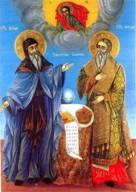 to Russia. There they taught the king all about the Christian faith. Many people were baptized. Finally, the brothers headed back to Constantinople. They went back to their monastery.
to Russia. There they taught the king all about the Christian faith. Many people were baptized. Finally, the brothers headed back to Constantinople. They went back to their monastery.
The next year, another messenger came, this time from the land of Moravia. The king there wanted someone to come who could teach the people in their own Slavic language. The emperor immediately thought of Constantine and Methodius, who learned from their friends in childhood. But, how to teach in the Slavic language? There was no alphabet for the sounds, so Constantine had to make up an alphabet to write down the teachings of Jesus. Then, the brothers wrote down the liturgy and parts of the Bible in the new alphabet. When they got to Moravia, they taught the people to read in their own language and started churches with liturgy in their own language. After several years, the brothers went back to the monastery. Constantine was very sick, and was tonsured a monk and given the name of Cyril. So the alphabet he invented is known to this day as the Cyrillic alphabet. Cyril died soon after, and Methodius went back to the Slavic countries as a bishop. He started more churches and trained Slavic priests. The Slavic people were so happy to have their own alphabet and Bible and Liturgy books. Finally, as an old man, Methodius died, still serving Jesus in the Slavic countries.
Even farther north, in deepest Rus, lived a queen named Olga. Olga made a visit to Constantinople and became a Christian and was baptized. But her people were still worshipping gods made of wood. Soon her grandson, Vladimir, became prince. He was not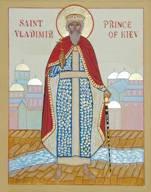 sure what religion was true. So Vladimir sent a group of men to each country to see if its religion was true. The men found beauty and truth in the Christian churches of Constantinople. But, Vladimir was still not sure what was best for his people. Vladimir offered to marry the sister of the Emperors Basil and Constantine. Her name was Anna. Anna did not want to go to Russia, but hoped that she could help the land of Russia to believe in Jesus. Vladimir, meanwhile, had gone blind; he could not see. He was told that he would not see until he was baptized. Vladimir decided this would be a test to prove the true God and was baptized. He was healed!
sure what religion was true. So Vladimir sent a group of men to each country to see if its religion was true. The men found beauty and truth in the Christian churches of Constantinople. But, Vladimir was still not sure what was best for his people. Vladimir offered to marry the sister of the Emperors Basil and Constantine. Her name was Anna. Anna did not want to go to Russia, but hoped that she could help the land of Russia to believe in Jesus. Vladimir, meanwhile, had gone blind; he could not see. He was told that he would not see until he was baptized. Vladimir decided this would be a test to prove the true God and was baptized. He was healed!
Now Vladimir wanted his people to know the true faith also. He burned their idols of wood – nothing happened. These were false gods with no power. Then he told all the people, rich and poor, young and old, to meet him on the banks of the Dneiper River the next morning. Prince Vladimir told them all about Jesus and their need to be baptized. They waded right into the river -- mothers, fathers, children, babies – all were baptized that day. So Vladimir is remembered as the “Baptizer of Rus”, equal to the apostles. And from there the gospel spread, from Rus, now Ukraine, to what is today Belarus and deepest Russia to the north.
- Work on the difficult names of these important saints: Cyril (originally Constantine), Methodius, Vladimir, and Olga. Does any student or their relative have one of these names; what about Walter, the English name for Vladimir? Which ones were missionaries/evangelists? Which were rulers? Which were monks?
- St. Cyril made a whole new alphabet for the Slavic people, now known as the Cyrillic alphabet. It is still used today in Russia and many Slavic countries. While to learn Russian would be a huge task, to become familiar with the alphabet, as an Orthodox Christian, is critical. Wouldn’t it be nice to be able to sound out the names of the saints on the icons in a Russian church? Look at the alphabet on the next page. Put a copy on the board or make a copy for each student. Sound out each letter as if it were a secret code. Then sound out the message at the bottom. Can each of you also write a short message in the Cyrillic alphabet for your classmates?
- Close with prayer: Lord, help me to love people who are different from me and speak other languages and to tell them about Jesus and bring them to Church to hear about You.
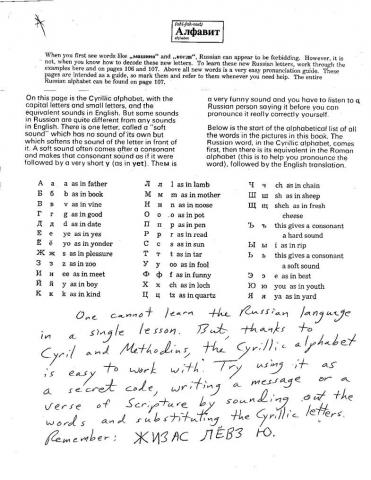
St. Gregory Palamas
ST. GREGORY PALAMAS
Objectives:
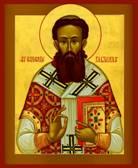 Students should know his name and be able to tell his story briefly.
Students should know his name and be able to tell his story briefly.- Students should know that Gregory defended the Holy Spirit in the Trinity.
- Students should memorize the Jesus Prayer.
Possible Lesson Plan:
- 1. Open with prayer.
- Tell the story of St. Gregory Palamas:
Gregory was born in the royal city of Constantinople more than a thousand years after the time of Jesus. At age 7, both of his parents died, and Gregory was an orphan. But, the orphan boy was a favorite of Emperor Andronicus II, who sent the boy to school, where Gregory studied all about science. Science, however, did not interest Gregory; his interest was in the Lord Jesus. He soon began studying about the Lord and gave up his life in the court of the emperor to spend his time in monasteries. He was only twenty years old.
When Gregory was 30 years old, he became a priest. He had learned well from the monks around Constantinople and Mt. Athos. They had taught him the Hesychast Prayer, or Jesus Prayer. The monks would bow in prayer, concentrate on the Lord, and recite, “Lord Jesus Christ, Son of God, have mercy upon me, a sinner.” As the monk prayed and prayed, over the years he would grow closer to the Lord and experience the light of the closeness of Jesus. With Jesus as the sun, Gregory and the other monks could feel the light and warmth of His shining rays. “Hesychast” means calm or silence – with busyness it’s not easy to draw close to the Lord! In fact, Gregory, as a priest/hermit, would spend 5 days as a hermit, drawing closer to God, and Saturday and Sunday ministering to the Lord’s people as a priest.
But, in those days, a man named Barlaam was teaching also. Barlaam had never been a monk; he had studied about Jesus but had not spent years in prayer just getting to know Jesus. In fact, Barlaam didn’t believe that people could get to know Jesus, not to really feel Him near, until after they died. He made fun of the monks and called them “Belly-button-gazers” because they spent so much time kneeling and bowing in prayer.
|
Gregory knew that Barlaam was wrong. Gregory knew Jesus in his heart and had felt His presence with him. Gregory had seen and felt the light of God -- the same light that St. Stephen saw as he was being stoned, that St. Peter saw when Jesus was transfigured on the mountain, and that St. Paul saw on the road to Damascus. He knew that the Lord was present with all of His followers since the coming of the Holy Spirit at Pentecost. This Holy Spirit, the same Spirit who appeared from heaven when Jesus was baptized in the form of a dove, was just as much a part of |
Later in life, Gregory was made Archbishop of Thessalonica. He suffered many times because of his teachings; he was thrown out of his home, was thrown in prison, and was even captured by the Moslem Turks. While a prisoner, awaiting ransom, Gregory even preached to the Turks. But, finally, before his death, two church councils in Constantinople held firm for Gregory’s teachings and told all of us that we can know and feel the presence of God in our daily lives.
- First discuss the Holy Spirit: Review the stories of the dove at Jesus’s baptism, the tongues of fire at Pentecost, the Transfiguration, the death of Stephen, and the conversion of Saul. Who are the persons of the Holy Trinity? Remember the sign of the cross and the three fingers, the shamrock and the three leaves of St. Patrick. Can you feel Jesus in your heart, as did Gregory Palamas? In the creed we learn, “the Holy Spirit proceeds from the Father; with the Father and the Son He is worshipped and glorified.” Do you remember which heresy put the Holy Spirit below the Father and the Son? (Macedonius, condemned by the Second Ecumenical Council)
4. Memory work for this week is the Jesus Prayer. As a learning game, play Jesus Prayer Scramble: Make two or three sets of cards, each with one card containing one word of the Jesus prayer. Divide the class into teams. Give each team a stack of cards, mixed up. See which team can first arrange the cards in the correct order. Can each student say the Jesus Prayer?
5. Make a Gregory Palamas bookmark: Cut out the front and back on the next page and glue to cardstock. Punch a hole at the top for the ribbon. After the children have colored the pictures, cover with clear Contac paper or laminate to waterproof (if desired) and tie a double pretty ribbon at the top.
6. Close with prayer: Practice bowing and saying the Jesus Prayer with the students until they know it by heart!
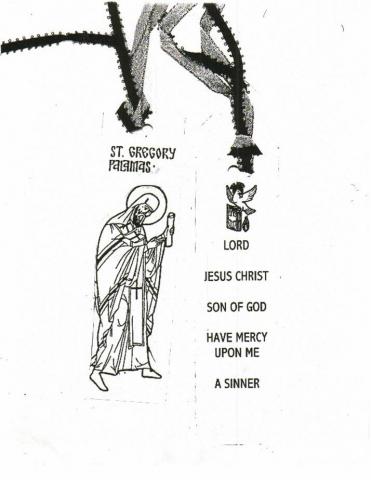
Crusades
THE CRUSADES
Objectives:
- Students should know the word, crusade, and that these were wars from Western Europe to take the Holy Land from the Moslems.
- Students should know that the crusaders did not win the Holy Land for Christians in the end.
- Students should know that the crusaders broke into the city of Constantinople and killed its Christian people and stole its treasures.
Possible Lesson Plan:
- Open with prayer.
- Tell the story of the Crusades:
We studied in an earlier lesson how the followers of a man named Mohammed conquered the Holy Land and the city of Jerusalem, the land where Jesus had lived, died, and was buried. Do you remember the story of Mohammed, the camel driver? What were his followers called? All thru the ages, Christians from all over the world would come to see the places where Jesus had lived, but these lands were now in the hands of Moslems.
Christians in the Western lands of Europe were very angry about the rule of the Moslems in the Holy Land. The Bishop of Rome, called the Pope (or Big Dad) by the Western Christians, called on his people to leave their homes and families behind and go to attack the Moslems. These new soldiers sewed great crosses on their clothes and painted them on their shields and armor; they were called Crusaders. Crusade means a war for the cross. Before long, thousands and thousands of people, young and old, men and women had joined the Crusade to go to Jerusalem. Poor people left their farms and huts, nobles and princes left their castles. Some rode on horses; some walked by foot. They traveled for four years and finally reached the walls of Jerusalem. There they thanked God for bringing them safely to the end of their journey and then they attacked the city. The first Crusaders captured Jerusalem! They built castles and claimed the land for themselves. They even had their own king.
But, soon the Moslems won the city back. It didn’t stay captured for many years. So, over the next two hundred years, every so often there would be another Crusade. Sometimes the Western Christians would win the city back again, but not for long; sometimes they didn’t win it back at all.
 The Third Crusade was a famous one – three kings led the Crusade. Frederick Red Beard of Germany started out, but drowned in a river along the way. Philip of France ran away back home because he was jealous of the third king. The third king was Richard of England. He was known as Richard the Lion-Hearted and loved by all. In fact, Richard even made friends with Saladin, the Moslem ruler of Jerusalem, who decided to let the Crusaders worship at Jesus’s tomb without even fighting with them! But, on the way home, Richard was captured by his enemies. He took so long coming home, that Robin Hood had to save England from his wicked brother, Prince John. Do you know the story of Robin Hood and his merry men? Did you know that the Crusades were the reason for King Richard’s disappearance?
The Third Crusade was a famous one – three kings led the Crusade. Frederick Red Beard of Germany started out, but drowned in a river along the way. Philip of France ran away back home because he was jealous of the third king. The third king was Richard of England. He was known as Richard the Lion-Hearted and loved by all. In fact, Richard even made friends with Saladin, the Moslem ruler of Jerusalem, who decided to let the Crusaders worship at Jesus’s tomb without even fighting with them! But, on the way home, Richard was captured by his enemies. He took so long coming home, that Robin Hood had to save England from his wicked brother, Prince John. Do you know the story of Robin Hood and his merry men? Did you know that the Crusades were the reason for King Richard’s disappearance?
Another Crusade was the Children’s Crusade; it was a crusade of children only. Children from all over France left their homes and mothers and fathers and marched to the sea. There some sailors told them they would take them to Jerusalem. But, they were really pirates and sold the children as slaves! (Do you remember another child sold by pirates as a slave? St. Patrick)
Many of the Crusaders truly loved the Lord. But, some saw the rich lands of the East as a way to get richer themselves. As they traveled toward the Holy Land, they stole from even the houses and churches of Christians in the lands they passed through. They conquered Christian cities and made themselves rulers over the people, killing their Christian kings. Greedy men who attacked the city of Constantinople itself and, on Good Friday, broke into the city, looting the monasteries and churches. The Eastern Christians could not understand this; why were their Christian brothers from the West attacking them instead of the Moslems? There were eight Crusades in all, and in the end the Holy Land was still ruled by the Moslems!
- Talk a bit about the difference in life at this time in the East and in the West. Look back at the lessons on the Fall of Rome and on Justinian. In the East, there was learning, beauty, art, jewelry, and beautiful churches. But, in the west, people lived hard lives, often hungry and dirty. Even the rich nobles lived in castles -- dark, smelly, and cold in winter. Food was scarce for most people. Show pictures of feudal life in the West and of Byzantine life in the East. Was it any wonder that the Westerners were tempted by the riches of the East?
- Play a learning game: Time Line Cards – Take about 15 index cards. On each one, write an event from the Crusades. Can the students place them in the right order? Display on your bulletin board and review next week. Some ideas?:
Mohammed born in Mecca.
Moslems capture Jerusalem.
Pope calls on Christians to take Jerusalem back.
People sew crosses to their tunics.
Jerusalem captured.
Crusaders build castles in Holy Land.
Frederick Red Beard of Germany drowned.
Richard the Lionhearted talks to Saladin.
Saladin allows Third Crusaders into Jerusalem in peace.
Richard the Lionhearted captured and imprisoned.
French children march to sea.
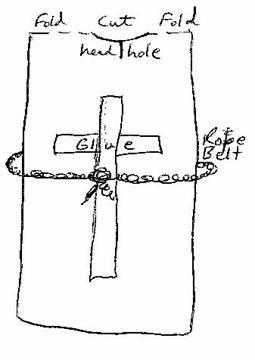 French children captured by pirates.
French children captured by pirates.
French children sold as slaves.
Crusaders attack Constantinople.
Crusaders steal riches of Constantinople.
- Make Crusader tunics: Take a large men’s white T-shirt or a length of white fabric with a head-hole in the middle. Cut a cross from red fabric and glue with fabric glue to each side of the tunic; or use 2 pieces of red ribbon for the cross. These could be used as nightgowns or at the beach. Budget doesn't run to shirts and fabric? Try paper grocery bags!
- Alternate craft idea: Take construction paper and paper towel and toilet paper tubes. Construct a Crusader’s Castle.
7. Close with prayer: Lord, may I love your cross more and more each day.
Fall of Constantinople
FALL OF CONSTANTINOPLE
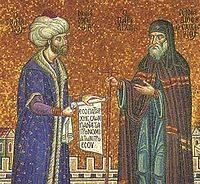 Objectives:
Objectives:
- Students should know that 1000 years after the fall of Rome, Constantinople fell to the Moslems named Turks.
- Students should have some idea why this is important in history.
Possible Lesson Plan:
- Open with prayer.
- Tell the story of the Fall of Constantinople:
In 1451 the Moslem Turks had a new king, Mehmet. Mehmet had only one idea in his mind; he told his generals, “There is only one thing I want: Give me Constantinople!” Mehmet was sure he could conquer the great capital of the Byzantine Empire. So, he gathered a great army to prepare for his attack, and built huge numbers of ships until he had the greatest navy in the East. He also built a great cannon, so big that it had to be drawn by 60 oxen and loaded by 200 men. The cannon was a new weapon; could the walls of the city withstand it?
Constantinople, weakened by the Crusaders, had only an army of 8000 soldiers and 30 ships. But, the city was built on a peninsula -- a strip of land surrounded on three sides by the sea. See the picture of the city on the next page. A giant cable, or boom, protected the Golden Horn side from enemy ships entering. There were huge walls around the whole city; these had held off many Moslem armies over hundreds of years. The Byzantine Christians sent a plea to the Bishop of Rome, the Pope, for help, but none was granted officially since the churches had officially separated 400 years before. Nevertheless, a few hundred soldiers and a dozen ships came across the sea to help their fellow Christians against the Moslems.
Mehmet moved his army into place on the day after Easter in 1453. He asked the Emperor to surrender and give the city to the Moslems; the Emperor would not give up that easily. Soon the huge cannons were pounding the walls, but the walls held. Mehmet’s ships held the waterways and kept food from reaching the city. But, he could not enter the city. Finally, Mehmet built a huge pontoon bridge across the water. Now his armies could attack from both sides. There were not enough Christians to defend the entire wall! The Christians were hungry and weak. But, they continued to fight.
Finally, the Turks prepared for their last big attack. The Emperor spoke to his people and told them to be ready to die for their Lord and their homes. Then the Christians all took communion in the many churches of the city and went to the walls to be ready for b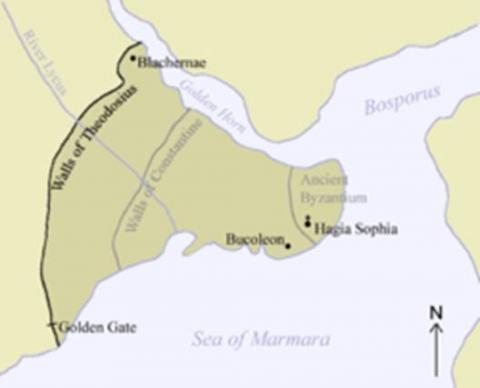 attle. In the middle of the night, Mehmet attacked. The thick walls of the city were no match for the huge cannon. This time his troops rushed up the walls of the city and charged into Constantinople. For three days, the Moslems sacked the city, killing all Christians they could find, stripping all the riches of the homes and churches, and burning whole sections of the wonderful city. The great Church of St. Sophia was renamed a Moslem mosque. The Byzantine Empire, outliving Rome by a thousand years, was finally defeated.
attle. In the middle of the night, Mehmet attacked. The thick walls of the city were no match for the huge cannon. This time his troops rushed up the walls of the city and charged into Constantinople. For three days, the Moslems sacked the city, killing all Christians they could find, stripping all the riches of the homes and churches, and burning whole sections of the wonderful city. The great Church of St. Sophia was renamed a Moslem mosque. The Byzantine Empire, outliving Rome by a thousand years, was finally defeated.
- Discuss for a bit weapons of war. Boys will like this lesson. What weapons can they think of? What were some early weapons? (bows and arrows, spears) Draw them. How might an army attack a city like Constantinople with these weapons? How did a war with these weapons sound? Look? How might the city be defended? How would a city be built so as to be easy to defend? With the invention of gunpowder and cannons (and later, guns), all war was changed. How might an army with cannons attack a city? What about sound and sights now? War has now become noisy! How can the city be defended? Were castles and walls as important as before?
- Play a learning game: Pass the Ball. Hold a small ball. Sit in a circle. Begin the story of the fall of Constantinople. Pass the ball to the next student, who must continue the story. He passes it to the next student and on and on until the entire story is reviewed.
- Make “Headline Stories”: Give students a pile of old newspapers. Have each come up with a good headline for today’s lesson, along the lines of “Walls of Constantinople Today Fall Before Turks”. Cut out letters from headlines in newspaper and glue to a piece of construction paper to make their own headline.
- Close with prayer: Lord, give us the courage of those brave Christians in Constantinople when Mehmet attacked.
Protestant Reformation: Part 1
THE PROTESTANT REFORMATION
Objectives:
- Students should know who Martin Luther was and what he did.
2. Students should be able to name some of the Protestant denominations.
Possible Lesson Plan:
- Open with prayer.
- Tell the story of the Protestant Reformation up through Martin Luther.
As the years went by after the fall of Rome in the West, the church there came to be led by only one bishop, the Bishop of Rome, known also as the pope. He began to teach that he was the ruler of all the Christian church and that he alone could tell the true teachings of God. His Churches were led by Rome and were called Roman Catholic. These churches in the West began to teach that a man had to pay for any sins he committed on earth and they sold indulgences to Christians to help them pay for their sins. Soon the church was wealthy, but the people had lost touch with the real Jesus in many ways.
 Finally, a monk named Martin Luther stood up against the church officials. He opposed the wealth of the church and the selling of payment for sins. He made a public announcement of his views by nailing a paper with 95 questions on it to the door of the cathedral, or church, of Wittenburg. But, the Pope was not happy with Martin Luther. He issued a decree throwing Luther out of the Church! Martin Luther built a bonfire and burned the decree. Luther had meant only to talk the church into going back to the old teachings of the apostles, but now he had no church at all. The Pope asked King Charles of Spain to talk to Luther. King Charles ordered Luther to come to the city of Worms – funny name for a city, right? When Luther got there, King Charles ordered Martin Luther to stop talking about the things he believed. Martin Luther refused. Some of Charles’s nobles thought Luther should be burned at the stake, Charles let him go and his friends hid him from the angry nobles. So, Luther formed his own church, soon called the Lutheran church. He translated the Bible into German, the language of his people, and soon had many followers who call themselves Lutherans. Martin Luther rejected the authority of the Pope, but he also rejected the authority of any church teachings. Each believer should read the Bible for himself and decide what it means. Risky business!
Finally, a monk named Martin Luther stood up against the church officials. He opposed the wealth of the church and the selling of payment for sins. He made a public announcement of his views by nailing a paper with 95 questions on it to the door of the cathedral, or church, of Wittenburg. But, the Pope was not happy with Martin Luther. He issued a decree throwing Luther out of the Church! Martin Luther built a bonfire and burned the decree. Luther had meant only to talk the church into going back to the old teachings of the apostles, but now he had no church at all. The Pope asked King Charles of Spain to talk to Luther. King Charles ordered Luther to come to the city of Worms – funny name for a city, right? When Luther got there, King Charles ordered Martin Luther to stop talking about the things he believed. Martin Luther refused. Some of Charles’s nobles thought Luther should be burned at the stake, Charles let him go and his friends hid him from the angry nobles. So, Luther formed his own church, soon called the Lutheran church. He translated the Bible into German, the language of his people, and soon had many followers who call themselves Lutherans. Martin Luther rejected the authority of the Pope, but he also rejected the authority of any church teachings. Each believer should read the Bible for himself and decide what it means. Risky business!
 In other countries, other men were also protesting the teachings of the Pope. John Calvin in Switzerland formed the Reformed Church. In his church, he began to choose those teachings of the Church Fathers that he would follow and those that he would not. For example, Calvin got rid of all monks, bishops, and priests. Soon his followers, known as Calvinists, had stripped their churches of all pictures, stained glass, candles, and robes; they would not dance or play games or go to the theater. And, even though at first Calvin had been attacked by the Pope, soon the Calvinists were punishing those who disagreed with their beliefs in Switzerland.
In other countries, other men were also protesting the teachings of the Pope. John Calvin in Switzerland formed the Reformed Church. In his church, he began to choose those teachings of the Church Fathers that he would follow and those that he would not. For example, Calvin got rid of all monks, bishops, and priests. Soon his followers, known as Calvinists, had stripped their churches of all pictures, stained glass, candles, and robes; they would not dance or play games or go to the theater. And, even though at first Calvin had been attacked by the Pope, soon the Calvinists were punishing those who disagreed with their beliefs in Switzerland.
 In the land of England, the church of Rome was also losing power; but for a different reason. King Henry the Eighth wanted to get rid of his wife and marry his new girlfriend and the Pope wouldn’t let him. So, Henry declared himself head of the new Church of England and took from the bishops and monks all the lands and churches of the Pope. When people from the Church of England came to the new land of America, they became known as the Protestant Episcopal Church of America.
In the land of England, the church of Rome was also losing power; but for a different reason. King Henry the Eighth wanted to get rid of his wife and marry his new girlfriend and the Pope wouldn’t let him. So, Henry declared himself head of the new Church of England and took from the bishops and monks all the lands and churches of the Pope. When people from the Church of England came to the new land of America, they became known as the Protestant Episcopal Church of America.
Soon there were many new teachers, each forming his own church with his own choice of teachings. A teacher named John Wesley pursued a way of life of Bible study and prayer; his followers became known as Methodists. John Calvin taught that people are chosen before birth to be Christians and believed that each church should vote on what to believe and who to follow; his followers are called Presbyterians. Another group of Christians under John Smyth believed that people should only be baptized when they are grown up; these were called Baptists. Another believed that Christians should worship on Saturday, the seventh day of creation; these were called Seventh Day Adventists and were led by William Miller of New York. By now there are hundreds of groups of Christians, called denominations, in the West, each with its own set of customs and beliefs. While all these groups believe in Jesus Christ, each has chosen only parts of the teachings of the early Church and left other traditions behind.
- Try singing 3 verses of the “Ants Go Marching”:
The Church goes marching one by one…the Orthodox Church is the only one
And they all go marching down, to the church, to worship the Lord.
The Churches go marching 2 by 2…the Roman Pope makes the church two,
And Roman Catholics go marching down…
The Churches go marching 3 by 3…Martin Luther nails up his scroll…and the
Lutherans go marching down…
- Play a learning game: Word Jumble. Can the students unscramble these words:
I am the head of the Church of Rome. OPEP
I was sold to buy the way to heaven. GEDSINCULEN
I was a monk who wanted to change the church. HETRUL
Martin Luther nailed his scroll in my city. TIBWURTENG
Followers of Martin are called by this name. RASHULENT
- Make “Denomination Scrolls”: First begin with a tin can or jar for each student. Cover with construction paper and title the can “Unroll a Scroll”. Give each student 2 pieces of paper. We’ll begin with the Roman Catholic and Lutheran Churches. Title each page and have the student add the necessary information. Add a pencil or piece of dowel at the ends with tape. Roll each up and tie with a ribbon. Put in the can and leave to finish next week. Use this table to help you:
|
Denomination |
Founder |
Place |
Date |
Beliefs |
|
Roman Catholic |
Pope Leo IX |
Rome |
1054 AD |
Pope as head |
|
Lutheran |
Martin Luther |
Germany |
1500s |
No pope Saved by faith alone Learn from Bible only |
|
Presbyterian |
John Calvin |
Switzerland |
1500s |
Predestination Democratic decisions Communion a symbol |
|
Episcopal/ Church of England |
Henry VIII |
England |
1500s |
Divorce his wife |
|
Methodist |
John Wesley |
England |
1700s |
Regular Bible study Communion a symbol |
|
Baptist |
John Smyth |
England |
1600s |
Adult baptism Communion a symbol Saved by faith alone No priests |
|
Seventh Day Adventists |
William Miller |
New York USA |
1800s |
Saturday worship No Communion Adult baptism |
6. Close with prayer: Lord make Your Church one again as we
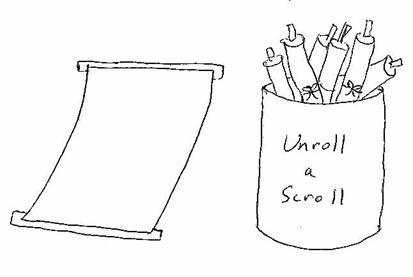 once were one.
once were one.
Protestant Reformation: Part 2
PROTESTANT REFORMATION, PART 2
Objectives:
- Children should know the name of Henry the Eighth of England and that he started the Church of England.
- Children should know that, sadly, the church is divided into many little churches today, some of their names and beliefs.
Possible Lesson Plan:
- Open with prayer.
2. Read the second half of the story of the Reformation above.
- Finish your little learning song; it’s really better if the students make up the lines (They’ll remember them better!), but if no ideas are forthcoming…
The Churches go marching 4 by 4…Calvin gets rid of all the priests…
Presbyterians go marching down…
The Churches go marching 5 by 5...King Henry gets rid of his Spanish wife…
Episcopalians go marching down…
The Churches go marching 6 by 6…John Wesley studies his Bible more…
Methodists go marching down…
The Churches go marching 7 by 7…Grown-ups only can be baptized…
And the Baptists go marching down…
The Churches go marching 8 by 8…Saturday is the most holy day…
Seventh Day Adventists go marching down…
- Talk a bit about the unity of the Church. Jesus prayed a whole chapter for His Church to be one. When did He pray this? (on Holy Thursday at the Last Supper) For 1000 years, there was only one Christian Church. But, in the West, as time went on, people couldn’t agree on exactly what to believe and how to worship. How did the Church in the first 1000 years settle any disagreements? They called a Church Council and made a decision all together. Now, without the councils, there is no one to decide. So, each teacher just makes his own church. How would Jesus feel when He sees His Church all divided up now? Do we feel sad, too? Jesus calls His Church His body. How would you feel if someone cut off a finger or a toe? Does it hurt to break the body of Jesus? Do you know anyone who goes to a Christian Church that is not Orthodox? A Roman Catholic? A Baptist? A Methodist? Do they love Jesus, too? Do you love them just as Jesus loves them?
- Play a learning game: Concentration. Take a piece of poster board or blackboard. Divide into a grid of 16 squares, 4 squares by 4 squares. Write each Western denomination in two scattered squares: Roman Catholic, Lutheran, Episcopal, Baptist, Methodist, Presbyterian, Seventh Day Adventist. Add the Orthodox Church in two squares. Cover each square with a post-it note. Number from 1-16. Students in order choose two numbers; if the same church, they get to keep the post-its and try again. If not the same church, the turn passes to the next player. Winner has the most churches in the end.
- Finish your Denomination Scrolls: Add the Episcopal Church (Church of England), Presbyterian, Baptist, Methodist, Seventh Day Adventist. Review as you fill in the data.
- Close with prayer: Lord, make your Church one, just like You are One.
Antioch: St. Raphael Hawaweeny
ST. RAPHAEL HAWAWEENY OF NEW YORK
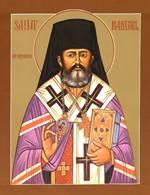 Objectives:
Objectives:
- Students should know the name of St. Raphael and be able to tell his story.
- Students should know his importance to the Antiochian church in America.
Possible Lesson Plan:
- Open with prayer.
- Have ready a map of North America and a copy of “The Word”. Tell the story of St. Raphael Hawaweeny, Bishop of New York:
Raphael was born in Syria in 1860 – just 150 years ago. But, in Syria Christians were still being persecuted, now by the Moslems and not by the Romans, and his family had to flee to Beirut, Lebanon, when he was a baby. Later, they returned to Damascus in Syria. There Raphael was a very good student in school. His parents were too poor to pay for his schooling, but the Deacon Athanasios asked the church to pay. Young Raphael was studying to be a priest. In fact, he was such a good student, that soon he was helping to teach. In seminary, Raphael was ordained a deacon; remember what a deacon was? He then studied in Halki, near Constantinople. But, he still wanted to learn, and he was sent to the Academy of Kiev in Russia. There he learned Russian and was ordained a priest, head of the Arabic Antiochian church in Russia. He stayed in Russia as a teacher.
But a call went out for someone to go to the new lands in America. There were Arabic Orthodox Christians there without a pastor. Fr. Raphael set off across the ocean. In less than 2 weeks, he had set up a chapel in New York and was celebrating services. The chapel was blessed by the Russian Bishop Nicholas – the head of all Orthodox in America.
Soon, Fr. Raphael heard of small communities of Arab Christians all over the continent. Many of these had no priest, no church. Who would help them maintain their Orthodox faith in this strange land, full of Protestants and Roman Catholics. Fr. Raphael set out across the country – to San Francisco and back. Follow his journey on your world map or globe. Remember there were no airplanes or cars in 1896; all travel was by train or boat. He performed marriages, baptisms, confessions, liturgies – often in homes where there was no church. For these Arab Christians, he produced an Arabic language service book. Later he would also begin the Arabic Christian magazine, “The Word”, still published today.
Fr. Raphael saw the need for more Arabic-speaking priests and received the Russian bishop’s blessing to bring many over from Syria. He traveled again around the country, visiting 43 cities and towns. He ministered to Greeks and Russians, too, all part of the Orthodox flock in America. Back in New York, he worked hard to provide a real church for the Syrian Christians in New York and a cemetery of their own. He loved America and, even when offered the role of bishop back in Syria, chose to stay in his new country. He learned English and began to use English in services and Church School.
After many years, the new Russian bishop said that he needed more bishops for the ever-growing church in America. Fr. Raphael was ordained a bishop in 1904 in New York – the first Orthodox bishop ever consecrated on American soil. As bishop, he ordained priests and started new parishes. He consecrated the grounds of St. Tikhon’s Monastery in Pennsylvania. He even traveled to Canada and Mexico. Finally, in 1915, Bishop Raphael Hawaweeny went home to be with his Lord, dying in his sleep. In the year 2000 he was named a saint, to be remembered on February 27, the day of his death.
- Begin the orientation of this young class to the unusual political situation of the Orthodox Church here in the USA. The first missionaries, as they will study later, were from Russia; St. Innocent is known as the apostle to America. All Orthodox in America, therefore, came under the authority of the Patriarch of Moscow – the Russian Church. Fr. Raphael was sent to America by the Russian Church and was consecrated a bishop by the Russians. He was Arabic by descent, but ministered to all Orthodox – Russian, Arabic, Greek. So, what happened? Why do we have so many little ethnic Orthodox Churches today? The Russian Revolution happened. In 1917, after the death of Bishop Raphael, the Communists took over Russia. The Russian Patriarch was killed; the church in America did not know where to turn. So, each group of immigrants turned back to the bishops of their home countries. So, to this day, we have Greek Orthodox, Antiochian Orthodox, Russian Orthodox, etc. We are one Church in America, but under the authority of a multitude of bishops and patriarchs in other lands.
- Play a learning game: Musical Questions. Make a circle of chairs, facing outward, with one too few for the number of students. Have your boombox ready (with Arabic music?) or sing the Troparion to St. Raphael:
Your proclamation has gone forth throughout North America,
Calling the scattered sheep into the unity of the church.
Hearing your voice, they responded to your teaching,
And thru your writings you instructed them in piety.
Now, guided by our example, O Father Raphael,
We sing hymns of praise unto Christ our God.
The students begin circling the chairs with the music. Stop the music at unexpected intervals. The student who does not get a chair is out – unless he can answer a question about today’s lesson.
- Make St. Raphael’s Countries Globe. Cut out the pattern on the next page. Color the water blue, and all of the countries where St. Raphael lived or visited red: Syria, Lebanon, Turkey, Russia, USA, Canada, Mexico. Fold on the dotted lines and tape the tabs. Poke two small holes for a string to hang it by in your window. There is no doubt that St. Raphael lived by Jesus’s command to “Go Ye.”
- Close with prayer: Lord, when I travel, may I be Your messenger and minister as was St. Raphael.
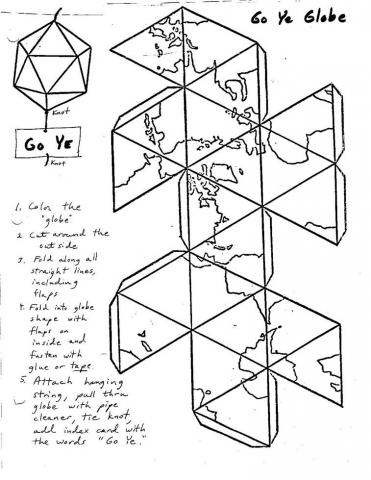
Egypt: St. Mark of Alexandria
ST. MARK OF ALEXANDRIA
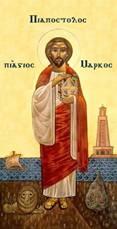 Objectives:
Objectives:
- Students should be able to identify Mark as the writer of the Gospel of Mark, written with St. Peter.
- Students should know that Mark went with Paul and Barnabas on their first journey, but went home partway through
- Students should identify St. Mark as the first bishop of Alexandria in Egypt.
Possible Lesson Plan:
- Open with prayer.
- Tell the story of St Mark; have ready the pictures of Holy Thursday and of Paul’s first missionary journey from their Bible storybooks:
St. Mark, author of the Gospel that bears his name, is met in the Scriptures with his Jewish name of John, meaning “Yahweh has shown grace”. “Marcus”, while a common Roman name, is an unusual name to find in a Jewish household; it is unclear where this name came from. In many early writings, John Mark bears the nickname, “stumpy-fingered”, possibly due to a physical peculiarity.
John Mark’s mother, Mary, was related to Barnabas, the wealthy landowner of Cyprus, who later became an apostle. Mary, a widow, was a woman of wealth and position in Jerusalem and a follower of Jesus. We meet John Mark in the Garden of Gethsemane as the young man wearing only a linen cloth who, when he was grabbed by the men arresting Jesus, fled naked.
John Mark’s home was a meeting place of the early Christians. In fact, when St. Peter was released from prison in Acts 12, he knows exactly where to go to find the Church. He is met there by the maidservant of the house and left standing on the doorstep until she tells the Christians inside, who joyfully let Peter in.
John Mark remained at home in Jerusalem until he was brought to Antioch by Barnabas and Paul. He traveled with the two to Cyprus on their first missionary journey. But, when the group reached Perga in Asia Minor, John Mark left them and returned to Jerusalem. Paul viewed this as desertion and refused to take John Mark with them on the second missionary journey. Barnabas separated from Paul and took John Mark with him to Cyprus and Paul traveled with Silas. Later, we find John Mark with Paul the prisoner in Rome, past history apparently forgiven. Paul sends Mark on several missions, first to Colossae and later, with Timothy to Asia Minor.
Mark was also a companion and helper of the Apostle Peter in his journeys. While Mark was with Peter in Rome, the faithful asked him to write down for them the life and miracles of the Lord Jesus and Mark wrote carefully that which Peter had witnessed. Peter chose Mark to preach the Gospel in Egypt, and Mark became the first bishop of Egypt. He taught in Pentapolis and then in Alexandria, where he founded a goodly church with priests and deacons. Mark’s teaching in Egypt was confirmed with many miracles. Finally, the pagans brought accusations against Mark and he had to flee back to Pentapolis. He spent two years in Pentapolis, where he continued his earlier work. After two years, Mark returned to Alexandria, to the great joy of the church there, which was growing mightily. But the pagans seized Mark and dragged him over the cobblestones to prison. An angel appeared to Mark in prison and then Jesus Himself appeared and said, “Peace to thee, Mark My Evangelist!” On the next day, the pagans dragged Mark through the streets until, bloody and injured, Mark went home to his Lord. His relics were buried by the Christians and have throughout the ages brought healing to many believers.
- Mark was all over! Review the stories of the major players in his life – Jesus at the Garden of Gethsemane, Peter being freed from prison, Paul and his first journey with Barnabas, Peter in Rome. But, finally, Mark was all grown up and was sent all by himself to teach the people of Egypt about Jesus. Review the stories of Egypt, especially Joseph and Moses. Egypt has figured heavily in history. Joseph and Mary even took the baby Jesus there to keep him safe from King Herod. Pictures of all of these events are in the students’ Bible storybooks. Look at pictures of Egypt – the pyramids, the Sphinx were all there when Mark was alive and are still there today! Mark ended his life as a martyr; do the students remember the meaning of “martyr”? Can they name some other martyrs? Who was the first martyr?
- Play a Guessing Game: Choose people from the life of St. Mark (e.g., Jesus, Barnabas, Paul, Peter) Write their names on slips of paper. A student draws a slip of paper. He begins to give clues to the other students, the goal being to make it as hard as possible for them to guess who he is. For example, beginning with “I am a man.” Then, “I am Jewish.” Etc. See how far he can get before the class guesses his identity.
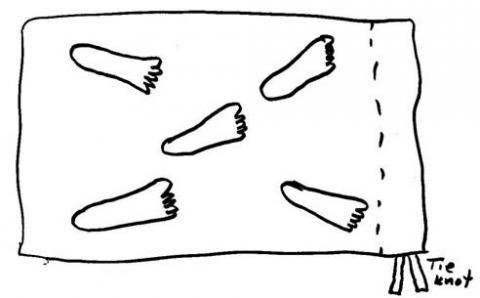 Make Mark’s traveling bag: Mark would definitely need a traveling bag; he went everywhere. Trace his journeys on a map if you want. What would he pack? Take a pillowcase. Cut a small section of the hem at the open end and insert a piece of clothesline or similar rope. Thread it through to close the bag and carry it. On one side, write with permanent marker, St. Mark’s Traveling Bag. Put on a smock (available in classroom) Now take off your shoes! Have each student dip his foot in paint (not too much!) and make footprints on the other side of the bag. Use acrylic paint so it will be permanent. Let dry till next week and take home.
Make Mark’s traveling bag: Mark would definitely need a traveling bag; he went everywhere. Trace his journeys on a map if you want. What would he pack? Take a pillowcase. Cut a small section of the hem at the open end and insert a piece of clothesline or similar rope. Thread it through to close the bag and carry it. On one side, write with permanent marker, St. Mark’s Traveling Bag. Put on a smock (available in classroom) Now take off your shoes! Have each student dip his foot in paint (not too much!) and make footprints on the other side of the bag. Use acrylic paint so it will be permanent. Let dry till next week and take home.
- Close with prayer: Lord, make Me your obedient and good traveler, going wherever You need me as did St. Mark.
Greece: Archbishop Athenagoras
ARCHBISHOP ATHENAGORAS
Objectives:
- Students should be able to say his name and tell his story.
2. Students should know that he was the first Greek bishop of the church in America.
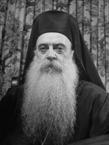 Possible Lesson Plan:
Possible Lesson Plan:
1. Open with prayer.
2. Tell the story of Archbishop Athenagoras of Greece and America:
For centuries the Greeks had been ruled by the Turks. Do you remember the Moslem Turks from our lessons on the Crusades and on the Fall of Constantinople? Spend a moment reviewing the founding and beliefs of Islam. Finally, almost 200 years ago, just after our country got its independence, the Greeks threw the Turks out of their country and were free to worship Jesus again. Remind the students that Constantinople is still ruled by the Turks and is called by its Turkish name of Istanbul.
Soon, Greek people were coming to our country – cotton merchants in the South, sponge divers in Florida – all wanted to have Orthodox Christian churches to worship in. They built churches and priests came from Greece. But, there was no bishop – no shepherd to lead the Greek people in America. Each church in each town just did what its priest thought was right. People argued; no one decided. Finally, Archbishop Athenagoras was elected by the bishops of Greece to be the first bishop of the Greek Church in America. He was a tall man with a long, flowing beard. He brought the churches together, built schools, started new churches. The Greek people in America had a leader for their flock. Do you remember what a bishop is? Bishop Athenagoras loved his people as a shepherd and cared for them until he died about 50 years ago.
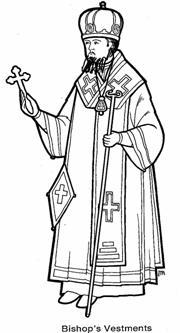 3. Review the role of a bishop: What was the role of the original deacons? How were new churches born in the New Testament days? How many churches were there in a city at first? The head of the city’s church was who? How did the need for more than one priest in a city develop?
3. Review the role of a bishop: What was the role of the original deacons? How were new churches born in the New Testament days? How many churches were there in a city at first? The head of the city’s church was who? How did the need for more than one priest in a city develop?
Who is the head of the bishop? (Christ Himself) What is the primary function of the bishop? (to perpetuate the church) What does a bishop oversee? (diocese) Who has the ultimate authority within a diocese? (the bishop) Who can ordain and through whose authority? Why can’t just anyone ordain a man if everyone can see he has the “gift”? What does “episkopos” mean? (overseer) Can a bishop be married? Show the picture of a bishop in his vestments. Have any of you seen a bishop?
What is the relationship between bishop, priest, and deacon?What sacraments does a bishop share with a priest and a deacon? How has the role of deacon changed through the centuries? What does the word “presbyter” mean? (representative) What does the word diakonos mean? (server or assistant)
- Play a learning game: Don’t Make a Move – Write numbers from 1-15 on Popsicle sticks. Dump the sticks in a pile on the table. In turn the students try to remove a stick from the pile. If a student moves another stick, he loses his turn and puts the stick back in the pile. If he removes the stick successfully, he must answer the question that matches the number on the stick. If he answers correctly, he keeps the stick. If not, the stick is put back in the pile. The student with the most sticks when all are chosen is the winner. Sample questions:
Who ruled Greece until 200 years ago?
Of what religion were the Turks?
Who was the founder of Islam?
Where was Mohammed born?
What is the holy book of the Moslems called?
What city fell to the Turks in 1453 AD?
What were the wars to regain Jerusalem from the Turks called?
When did Greece win its independence?
Who was the first Greek bishop in America?
Who oversees the priests of an area?
What is the territory of a bishop called?
Who is ordained as a server or helper?
Who is ordained to care for a local church?
Who has authority to ordain priests?
Is a bishop married?
5. Look at some pictures of Greece. What are its buildings like? The weather? The houses, people, clothing, customs? How are these like us and how different? What about food? Has anyone eaten Greek food? Can you remember some of the dishes? We will be making Greek sweet biscuits called Koulourakia in class. Do you like Greek food?
6. Look briefly at the Greek alphabet. No, you don’t have to learn the entire alphabet today. But, as Orthodox Christians, given that the Greek nation is Orthodox as well, that all of the early Scriptures are written in Greek, and many icons have the names of the saints written in Greek, not to mention the Greek found in our own cultures in the names of sororities and fraternities, etc., to know the alphabet would be useful. Here it is – look it over and perhaps write on the board. Recognize some letters from Russian Cyrillic alphabet?
7. Make Koulourakia: Make dough ahead of time and bring to class.
4 eggs: beat whites till stiff, then beat in yolks, one at a time.
2 cups sugar, 1/3 cup OJ, 2 tsp vanilla, ½ cup melted butter: beat all in in that order.
6-7 cups flour with 3 tsp baking powder: Add slowly until batter becomes a soft ball.
Knead till elastic. Then let students shape their sweet biscuits with a walnut-size piece rolled into a long snake, brush with beaten egg, and bake on greased cookie sheet 350 degrees for 15-18 minutes. Enjoy!
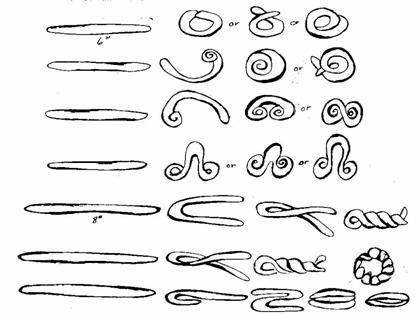
8. Close with prayer: Lord, we thank you for Your bishops who care for Your churches all around the world and pray for them every day.
Serbia: St. Lazar
ST. LAZAR OF SERBIA
Objectives:
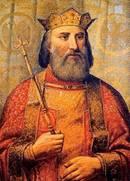 Students should be able to tell the story of St. Lazar.
Students should be able to tell the story of St. Lazar.- Students should be able to locate Serbia on a map of the world.
Possible Lesson Plan:
- Open with prayer.
- Tell the story of St. Lazar and the Battle of Kossovo:
The year 1389 marked the bitter defeat of the Serbs in the face of the Turks. But, why do the people of Serbia rejoice on that day and celebrate it as a national holiday? Instead of independence (Remember our 4th of July?), the Serbian people on that day lost their freedom.
The Tsar of all Serbia in that day was named Lazar. The ruler of the Turks was Sultan Murat. Murat sent to Lazar a letter. He demanded that Lazar turn over the country to him. If not, he would meet him on the Field of Kossovo and their armies would decide the fate of the nation. But, Lazar know that even more was at stake. The Turks had taken Constantinople and Greece. Serbia was the only country standing between the Turks and the rest of Europe. Lazar had asked for troops to help his small nation fight the mighty Turks. But the other European countries didn’t see their danger; they would not help little Serbia in its time of need. What should Lazar do now? He could not give up without a fight.
The evening before the great battle, as Tsar Lazar had dinner with his wife, Tsaritsa Militsa, she asked him if one of her nine brothers could stay home from the battle tomorrow. Both of them knew that death awaited the men on the battlefield. The Tsar agreed that a brother could stay behind to care for his sister. The next morning, the Tsaritsa waited at the city gates. One by one her brothers and father passed by; one by one they refused to stay behind. They would fight with their Tsar for the beloved land of Serbia!
On the evening before the battle a grey falcon flew away from Jerusalem, carrying a letter from the Virgin Mary on its back. The falcon was Elijah the Prophet. Do you remember his story? He dropped the letter on the knees of the Tsar. As Lazar read the letter, he grew sad. The Theotokos gave him a choice: if he chose an earthly kingdom, he would win the battle, but if he wanted the heavenly kingdom, he should build a silken church on the Field of Kossovo, take Communion, and prepare to die at the hands of the Turks. Lazar knew that an earthly kingdom would last only a short time, but a heavenly kingdom for eternity. He built the silken church and took Holy Communion with all his soldiers.
The next day, at first it seemed as if the Serbian forces could win the battle. The Tsaritsa’s 9 brothers and old father rode gloriously into battle, but all died. As each of Tsar Lazar’s forces entered the fight, they killed many Turks, but there were so many Turks! Then, one of the Tsar’s generals betrayed him and turned and fled from the battlefield. His men followed him. Tsar Lazar lost the battle and his life. But, all was not lost. When all of Europe heard of the Battle of Kossovo, they united and prepared to fight the Turks. The rest of Europe was safe because of the sacrifice of the Serbian nation.
- Look at a map of Europe. Constantinople, Greece, and Bulgaria were already in the hands of the Turks. All of the Holy Land and northern Africa were also in Moslem hands. Southern Spain had also fallen. Do you remember how France was saved? Charles the Hammer turned the Moslems back at the Battle of Tours. The Christian nations of Western Europe were at great risk. Remember that Mohammed promised immediate entry into heaven for any Moslem who died in battle fighting “infidels”. Hundreds of years after Charles the Hammer, little Serbia stood between the Turks and Austria, Switzerland, and Italy. So the defeat in the Battle of Kossovo, just like the earlier victory in the Battle of Tours, united Europe against their common enemy. Slowly the Moslems would be pushed back – by Isabella and Ferdinand in Spain (Remember them from the stories of Columbus?) and, finally, from Greece and Bulgaria. Serbia and Greece won their freedom about 200 years ago, after about 500 years of Turkish rule. Only Turkey itself, with its capital of Istanbul (Constantinople) remains in Turkish hands.
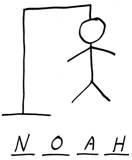 Play a learning game: Hangman – Use names from this week’s lesson. Draw a gallows with dashes beside it for each letter of the name. As the students guess letters in turn, either write the letter in the name on its space or draw a part of a body. Will the man be hanged before the students guess the name? Some names to try:
Play a learning game: Hangman – Use names from this week’s lesson. Draw a gallows with dashes beside it for each letter of the name. As the students guess letters in turn, either write the letter in the name on its space or draw a part of a body. Will the man be hanged before the students guess the name? Some names to try:
Lazar
Militsa
Murat
Kossovo
Serbia
Elijah
Theotokos
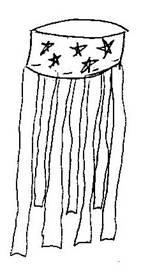 Make Lazar’s Banner: Lazar’s troops rode into battle with banners ablaze with golden crosses. We’ll make a windsock to fly in his honor. Take a piece of tagboard or foam, maybe red for the blood of the brave soldiers or purple for the Tsar, 8x18 inches. Bend into a circle and staple. Decorate with gold crosses – cut from wrapping paper, or gold glitter glue. Can you do different styles of cross? Use streamers of red, white, and blue – the colors of Serbia – of crepe paper stapled on. Add a hanging string and display proudly for Lazar’s brave death for a heavenly kingdom.
Make Lazar’s Banner: Lazar’s troops rode into battle with banners ablaze with golden crosses. We’ll make a windsock to fly in his honor. Take a piece of tagboard or foam, maybe red for the blood of the brave soldiers or purple for the Tsar, 8x18 inches. Bend into a circle and staple. Decorate with gold crosses – cut from wrapping paper, or gold glitter glue. Can you do different styles of cross? Use streamers of red, white, and blue – the colors of Serbia – of crepe paper stapled on. Add a hanging string and display proudly for Lazar’s brave death for a heavenly kingdom.
6. Close with prayer: Lord, give me as much love for You as had St. Lazar.
St. Nicholas of Japan
ST. NICHOLAS OF JAPAN
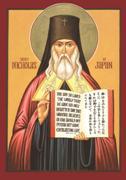
Objectives:
- Students should be able to name Nicholas as the evangelizer of Japan.
- Students should know a bit about the Japanese culture and language.
Possible Lesson Plan:
- Open with prayer.
- Tell the story of St. Nicholas of Japan:
John Kasatkin was born almost 200 years ago in the land of Russia. John’s mother died when he was only five years old. John and his father were very poor, but John was smart and studied hard in school. In school, John heard about many lands far away – China and Japan. He wanted to tell the people of these lands about Jesus.
Then one day a note was put up on the bulletin at John’s school. The Russians in Japan were asking for a priest. John had finished his studies to be a priest. He first became a monk, and was given the name, Nicholas. Then he was ordained a priest. He was ready to go to Japan.
But, the samurai who ruled Japan hated all foreigners! They had their Shinto religion and did not want anyone talking about Jesus. One samurai appeared before Nicholas, angry at very thought that foreigners would come to change their beliefs. But Nicholas showed such love, the man could not hate him. Nicholas spent several years waiting, but while he waited he learned the language and customs of the Japanese people. Officially, Nicholas taught Russian to Japan’s future ministers and teachers. But, a few came to him in secret and learned about the Christian faith. Finally, Takuma Sawabe, the angry samurai, became Fr. Nicholas’s first convert. Many of these early believers including Sawabe were thrown in prison, just as the Romans had the earlier Christians. Not one of these Japanese Christians denied his faith.
Finally, the rulers allowed the Christian faith. Nicholas could print Bibles in the Japanese language and open churches and teach priests. Foreigners were still not allowed in most parts of Japan, but these new Japanese priests could tell the people all over the country about Jesus. Soon there were hundreds of Christians all over Japan. Nicholas opened schools, both for boys and girls. This was new for the Japanese; girls usually did not go to school.
Nicholas became the first bishop of Japan. He built the beautiful Holy Resurrection Cathedral in Tokyo. He traveled all over Japan visiting Churches. He loved the Japanese people, so much so, that he stayed in Japan during the Russian-Japanese war, even though many of the Japanese rulers thought he was a spy! Nicholas died at the age of 76 in his beloved Japan and is called “Equal to the Apostles”.
- Talk a bit about Japanese culture: This time, act it out. Have the children take off their shoes and line them up at the door. Bring some small blankets they can lie down on and roll up along the walls of the classroom. Teach a few words of Japanese, bowing a bit when saying “Ko-nee-chee-wah”, or “Hello”. Have a cup of tea, sitting on the floor, bowing to each other. Talk about the importance of learning other people’s ways, which shows you respect their customs. This is what Nicholas did in Japan; he learned the Japanese language, good Japanese manners, ate Japanese food, and lived in a Japanese home. He was loved for this by the Japanese people.
- Play a learning game: The Big Step – Line the students up against the far wall of the classroom, with the teacher at the other end. Ask a question from today’s lesson of each student in turn. If he can answer the question correctly, he can take one step toward the teacher. If not, the question goes to the next student. First student to reach the teacher is the winner. Some questions:
What was the birth name of St. Nicholas of Japan?
Where was he born?
What was the religion of Japan?
Who was Nicholas’s first convert?
What were the rulers and priests of the Japanese people called?
Who was the first bishop of Japan?
What was the first cathedral built in Japan called?
How old was St. Nicholas when he died?
Nicholas is called “Equal to Whom”?
- Make a Japanese pearl necklace: Japan is known for its pearl divers. Do you know where pearls come from? Use a piece of fishing line for the necklace. Buy a bag of mixed size fake pearls. There is no need to put enough pearls on the line to go all the way around the neck. Use 10-12 pearls per student and make a beautiful necklace arranging them by size. In the end, tie the ends to fit exactly around the neck but able to get over the head; alternatively, you can purchase necklace fasteners and tie one on each end. The knots must be cemented with household cement or something similar; fishing line will otherwise untie itself! The boys can make these for their mothers.
- Alternate craft idea: Make an origami dove. Use the pattern on the next page.
- Close with prayer: Lord, help me to love other people enough to learn what they like and do things their way.
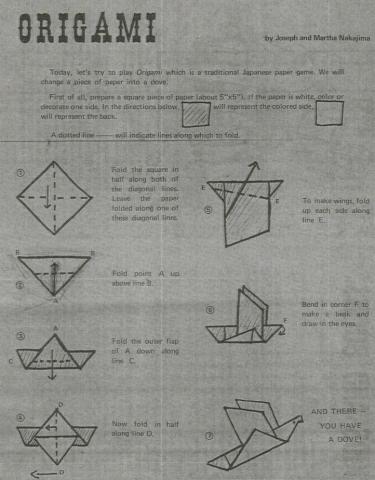
Russia: St. Sergius
ST. SERGIUS
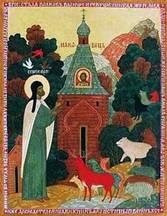
Objectives:
- Students should identify St. Sergius as one of the most famous Russian saints.
2. Students should know that he was the inspiration for the defeat of the Tartars.
Possible Lesson Plan:
- Open with prayer.
- Tell the story of St. Sergius:
Over 600 years ago in the land of Russia was born a boy named Bartholomew. His family had once been rich, but their wealth had been stolen and their town burned by the Mongolian Tartars. They lived like peasants, but there was always a place for the stranger to eat and sleep in their home. Bartholomew grew and went to school, but he somehow couldn’t learn to read. He was very sad about this; his father was very angry. One day, while he was seeking a lost herd of horses, Bartholomew saw a monk sitting under a tree. The boy told the monk about his difficulties with reading. The holy monk gave the boy a small loaf of blessed bread and told him that the bread was as sweet as the Holy Scriptures would be when he could read them. Bartholomew ate the bread; it was sweet as honey. The monk told him not to worry about reading any more. Bartholomew invited the monk to spend the night with his family. The monk and Bartholomew’s family read the Scriptures that night. Bartholomew could read perfectly!
When Bartholomew grew up, he wanted to be a monk. But his parents were very poor. Who would care for them when he left. So, Bartholomew stayed with his parents and cared for them until they died. Then he went into the woods, and built a small hut and chapel. At first, his older brother, Stephen, also a monk, went with Bartholomew. But, Stephen did not like the wilderness and returned to his monastery. Bartholomew was alone. For months he saw no one. He devoted himself to prayer.
There was little to eat so deep in the wilderness. One day, a hungry brown bear, taller than Bartholomew, came to visit. There was a piece of bread on the table. The man shared it with the bear and they became friends. Later, a visiting monk gave him the new name Sergius.
Word reached the outside world of the holy hermit living in the forest. Other monks came to build huts near his and learn from his example. Soon the bishop named him abbot of the monastery that had grown around him. This was a different type of monastery – a monastery in the wilderness. But, Sergius never ordered the other monks to do anything; he led only by example. He served his brother monks, helping in all the work of the monastery. He was so humble, that people often mistook him for a servant. Once a peasant came to meet the famous monk, Sergius. The other monks pointed out the old, shabby man tending the garden. The peasant was very upset; this could not possibly be Sergius. Then, a prince rode up on his richly decorated horse. He dismounted and bowed before Sergius. The peasant realized his mistake and begged the forgiveness of the famous monk.
Once the Grand Prince Dmitri, ruler of all Russia, came to Sergius. He told Sergius about the Moslem Tartars massing their armies to destroy the Christian army and capture the women and children, forcing them to give up their faith and customs. Sergius told the prince to humbly offer the Tartars peace and all the riches of the land. But the Tartars continued to gather their armies. The Russian army was small and weak. Dmitri was sure they could not win. But, Sergius told Prince Dmitri to trust the Lord. God would help him win, because he was fighting not for riches but for the heart and soul of his people. And so Prince Dmitri went to battle, a small force against the mighty Tartars. For the first time in Russian history, the Tartars were defeated! Russia was saved.
- Review a bit about Russian history: Remember Cyril and Methodius, evangelists to the Slavs. The Russians use the Cyrillic alphabet to this day. And review the baptism of Russia. Who was called “Equal to the Apostles” because of his role in the conversion of Russia to Christianity. For many centuries, the Russian Church and its bishops looked to the Patriarch of Constantinople. But, finally in 1448, just before the fall of Constantinople, the Patriarch of Constantinople recognized the bishop of Moscow, Bishop Jonah, as the Metropolitan of Moscow. Now review the Fall of Constantinople – Constantinople, Antioch, Alexandria, and Jerusalem – all of the old eastern patriarchates – were in Moslem hands. Rome had split even earlier. Moscow’s Metropolitan now became a Patriarch. To the Patriarch of Moscow fell the leadership of the Eastern Orthodox Church. The Byzantine Empire was no more; Russia was the largest and mightiest Christian nation in the east. Moscow became the “third Rome”. Into this situation, come the Tartars, threatening Russia and her Christian faith. St. Sergius, with his wise and godly advice, gave Prince Dmitri the courage to face the Tartars and save the nation.
- Play a learning game: Time Cards. Write each major event on an index card. Mix them up. Can the students put them in order?
King Constantine and the Edict of Milan
Fall of Rome
Mission of Sts. Cyril and Methodius
Baptism of Russia
Split of Rome from other Patriarchates
Crusades
Sack of Constantinople
Fall of Constantinople
Patriarch of Moscow
Birth of St. Sergius
Prince Dmitri’s Victory
- Make St. Sergius’s sweet Scripture bread: Take a piece of nice, thick bread for each student. Have the student use a toothpick and food coloring to write a favorite Scripture on the bread. Then, spread the bread with honey and enjoy your sweet snack.
- Close with prayer: Lord, give me the humility and faith of St. Sergius.